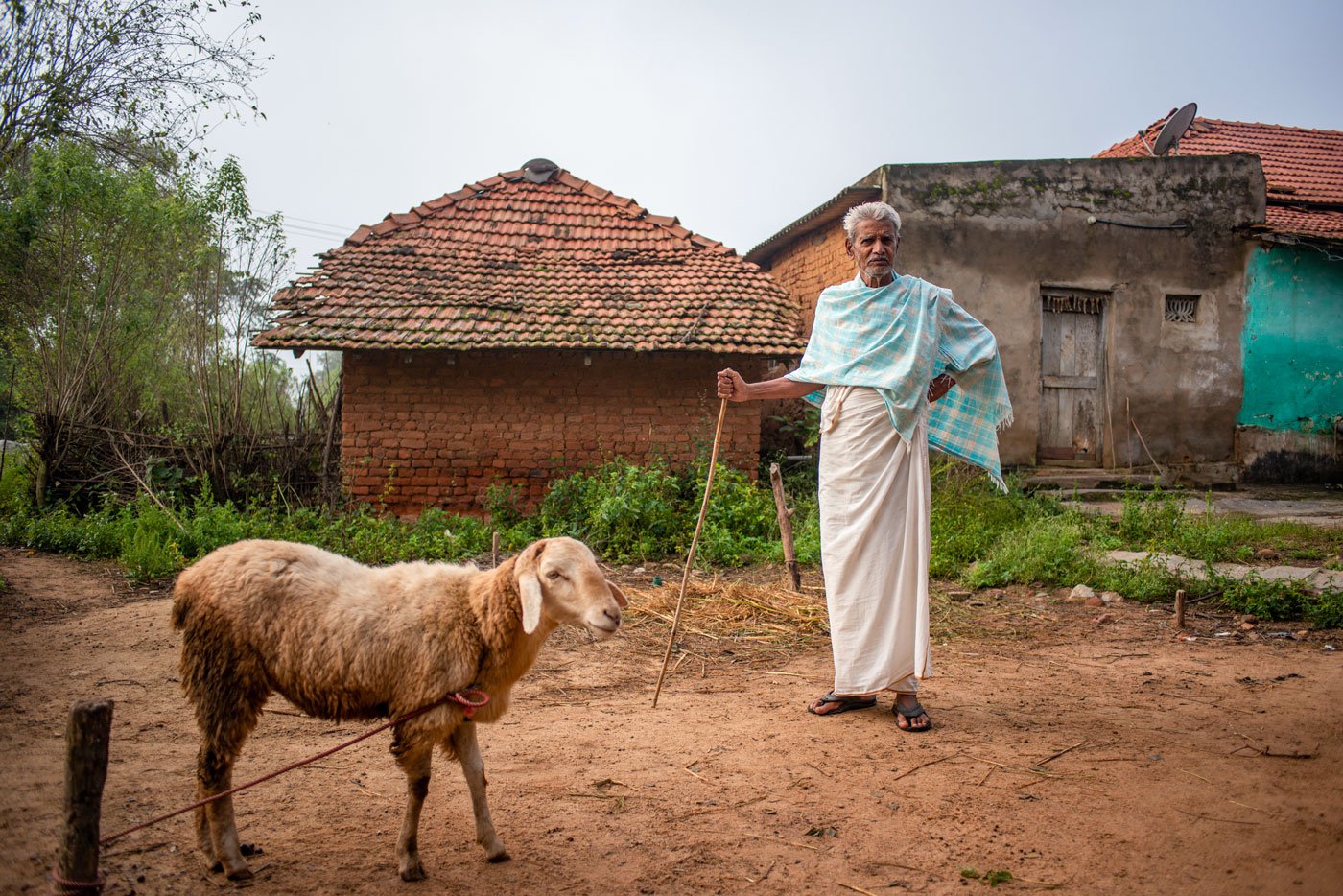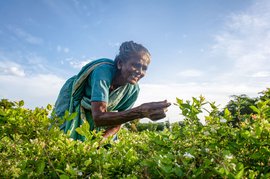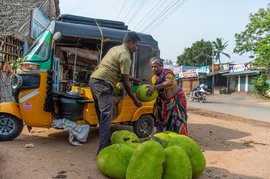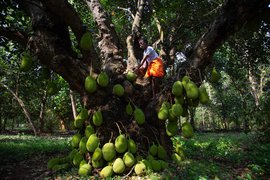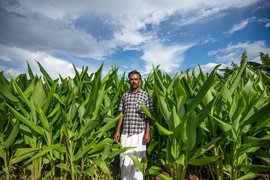Nagi Reddy lives in Tamil Nadu, speaks Kannada, and reads Telugu. Early one December morning, we walk a few kilometres to meet him. His house is, he tells us, a casual “just over there”. Actually, it was around the flooded lake, past the big tamarind tree, up the eucalyptus hill, down the mango grove, next to the guard dog, the squealing pup and cattle shed.
In addition to all the usual problems and headaches any farmer in the country faces, Nagi Reddy has another that bothers him to the point of changing the crops he grows. He’s being hounded by three tough and feared characters: Mottai Vaal, Makhana and Giri.
Farmers here have learned that these guys are not to be taken lightly – figuratively or literally. Not when they weigh between 4,000 and 5,000 kilos each. Locals may be forgiven a lack of enthusiasm in checking out up close the exact weight and height of these marauding elephants.
We are in Krishnagiri district that borders two states – Tamil Nadu and Karnataka. And Nagi Reddy’s hamlet, Vadra Palayam, in Denkanikottai taluk , is not far from the forest, not far from the elephants, and his cement verandah, where we’re seated, is a few metres from his fields. Naganna, as he is called by the villagers, is 86 years old and is a farmer who cultivates ragi (finger millet) a highly nutritious cereal. He is also a witness who recalls every churn in agriculture over the decades – the good, the bad and often, the terrible.
“When I was young, aanai (elephants) came a few days during the season, when the scent of ragi attracted them.” Now? “They come often, they’re used to eating the crops and fruits.”
There are two reasons, Naganna explains in Tamil. “After 1990, the number of elephants in this forest went up, while the size and quality of the forest came down. So, they show up here for their meals. And just like you’d tell your friends when you go to a nice hotel, they tell theirs,” he sighs and smiles. The ironical comparison amuses him, surprises me.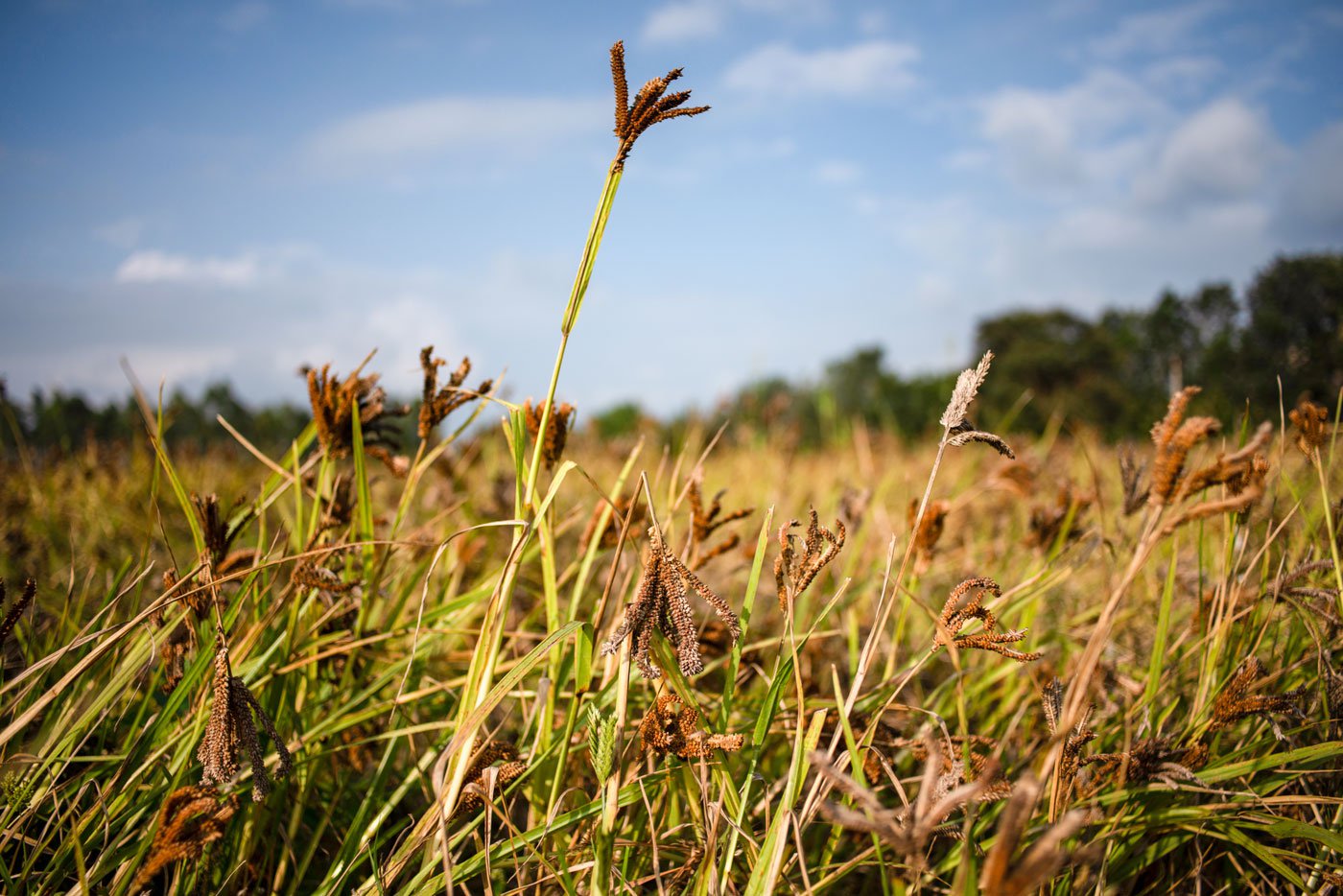
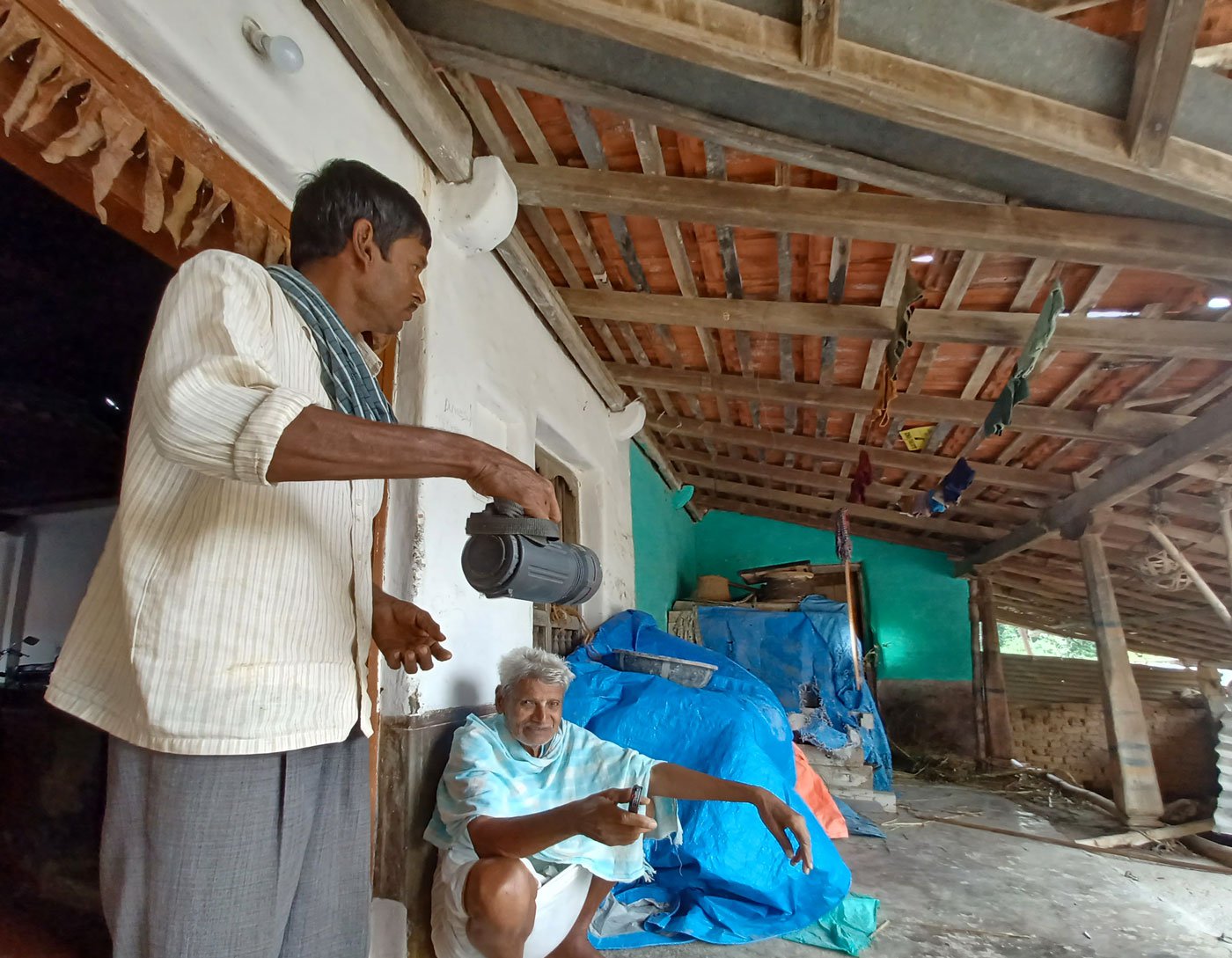
Left:
Ragi
crop ready for harvest
in Nagi Reddy’s fields. Right: Nagi Reddy looks on as his son Anandaramu demonstrates the brightness of the LED torch given by the forest department to drive elephants away
How do they send them back to the forest? “We make koochal [a lot of noise]. We shine the battery,” he explains, pointing to an LED torch. His son Anandramu, more familiarly called Ananda, turns on the light that the forest department gave him. It’s a bright, white light, with a good throw. “But only two elephants go away,” Naganna says.
“Mottai Vaal turns away, shielding his eyes, and continues eating,” Ananda demonstrates, walking to a corner of the verandah, showing his back to the torch. “Mottai Vaal will not go until he’s eaten fully. It’s as if he’s saying: you do your job – shining the torch, and I’ll do mine – eating till my belly is full.”
Since his belly is large, Mottai Vaal eats everything he can find. Ragi is his favourite. So is jackfruit. If he can’t reach the high branches, he places his front legs on the tree, uses his long trunk and plucks. If the tree is still higher, well, he simply knocks it over. And feasts on the fruit. “Mottai Vaal is 10 feet tall,” says Naganna. “And he can reach another six or eight feet if he props himself on two legs,” adds Ananda.
“But Mottai Vaal doesn’t hurt humans. He eats the corn and mangoes, he tramples whatever crop is on the field, and what the elephants leave behind, monkeys and wild pigs finish,” says Naganna. We have to be on guard all the time. If not, even the milk and curd will be gone, as monkeys raid the kitchen.
“As if this is not enough, wild dogs eat our chicken. And leopards come down and eat our guard dogs. Just last week…” His forefinger traces the big cat’s hunting route, and I shiver. It’s not just the morning chill but also the thought of living on the edge, amidst the uncertainties.
How do they cope? I ask. “We’re growing just enough ragi for our house, on half an acre,” Ananda explains. “At 2,200 rupees for an 80-kilo sack, the price is too low for us to see a profit. Plus, there is this unseasonal rain. And whatever’s left, the animals eat,” he says” We’ve switched to eucalyptus trees in one of our fields. And others in this region have gone from ragi to roses.”
Elephants don’t care for cut flowers. Not yet, anyway…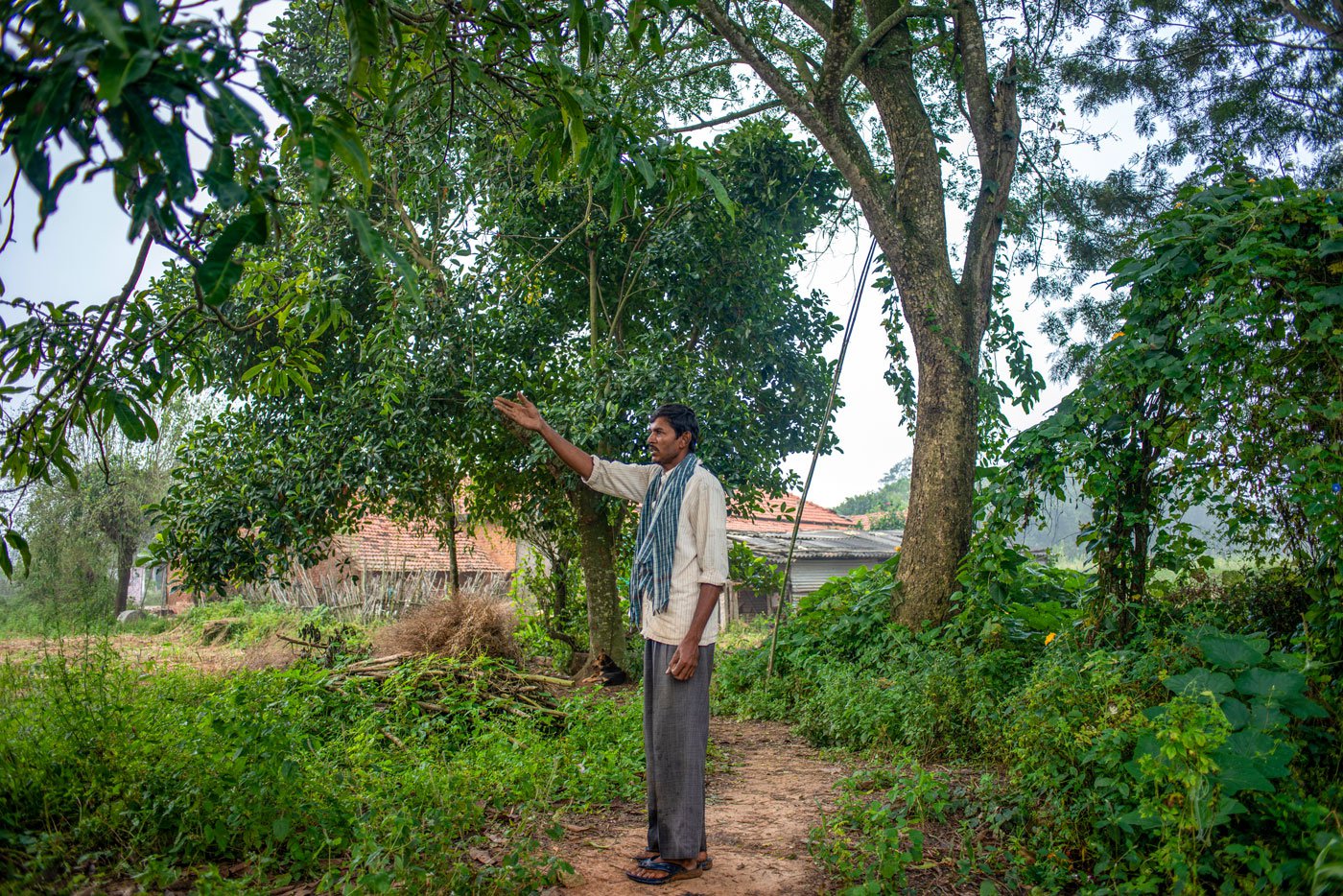
Anandaramu shows the elephants' path. The animals come often to eat crops and fruits
*****
I waited on the swing next to the millet field
where we chase away parrots, and when he came,
asked him, “Sir, push my swing a little”;
saying “fine, girl!” he pushed the swing;
pretending to lose my grip, I fell on his chest;
Thinking it was real, he rushed to hold me tight;
I lay still as if I had fainted
These amorous lines are 2,000 years old, from ‘ Kaliththokai ’, a poem of the Sangam era, written by Kapilar. The reference to millets wasn’t unusual, says Chenthil Nathan, who runs OldTamilPoetry.com , a blog that carries his translations of poetic works from Sangam literature.
“Millet fields are the backdrop of love poems in the Sangam canon,” says Chenthil Nathan. “A basic search shows that millets are mentioned 125 times, which is slightly more than the number of references to rice. So it would be safe to assume that millets were important grains for people of the Sangam era (approximately 200 BCE - 200 CE). Among that group , thinai (foxtail millet) features predominantly, followed by varagu (either ragi or kodo millet).”
Ragi originated in Uganda, East Africa, writes K.T. Achaya in his book Indian Food: A Historical Companion . It made its way to southern India many thousand years ago and was found “at the Hallur site (1800 BCE) in Karnataka on the river Tungabhadra” and “at Paiyampalli in Tamil Nadu (1390 BCE)”. That’s around 200 kilometres from Naganna’s house.
Tamil Nadu ranks second in ragi production in India – after Karnataka which leads the pack – and the annual harvests touch 2.745 lakh metric tonnes. Krishnagiri district, where Nagi Reddy’s village is located, alone produces 42 per cent of the state’s ragi .
The United Nations Food and Agricultural Organisation (FAO) counts many ‘special features’ of finger millet. Among them, ragi can be intercropped with legumes to generate extra income. It can produce reasonable yields with low inputs and survives on soils of low fertility.
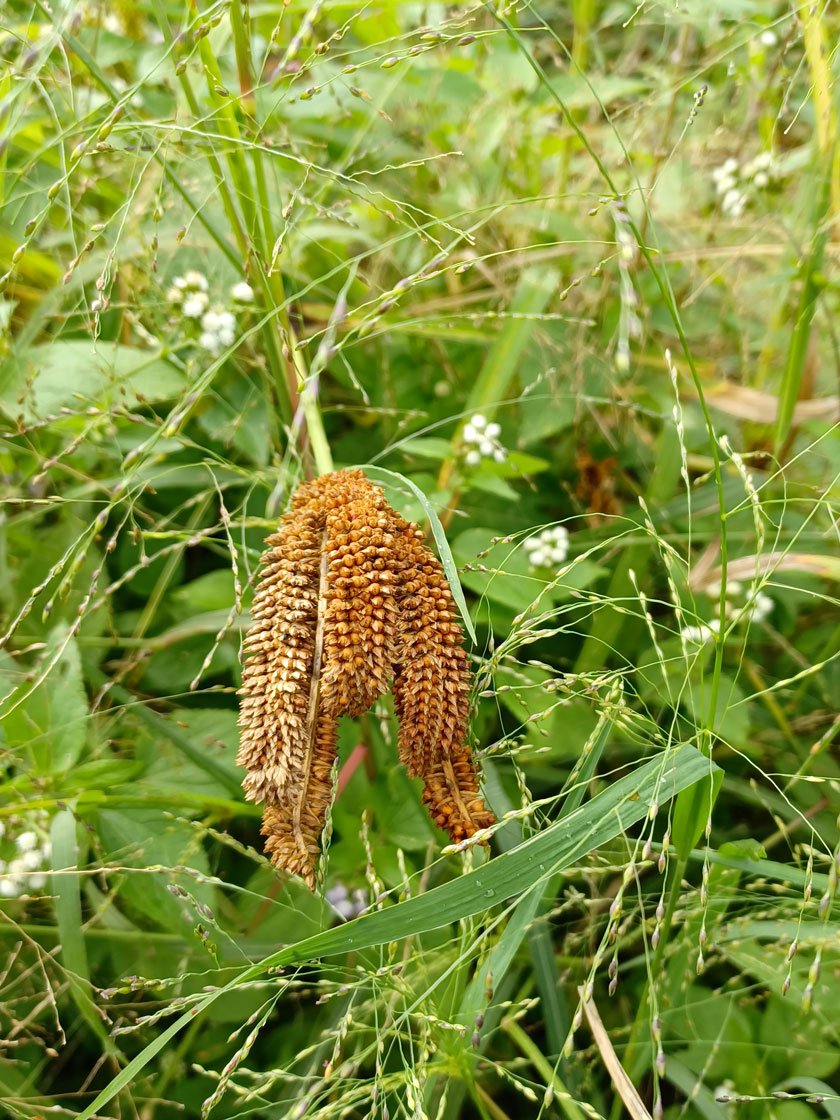
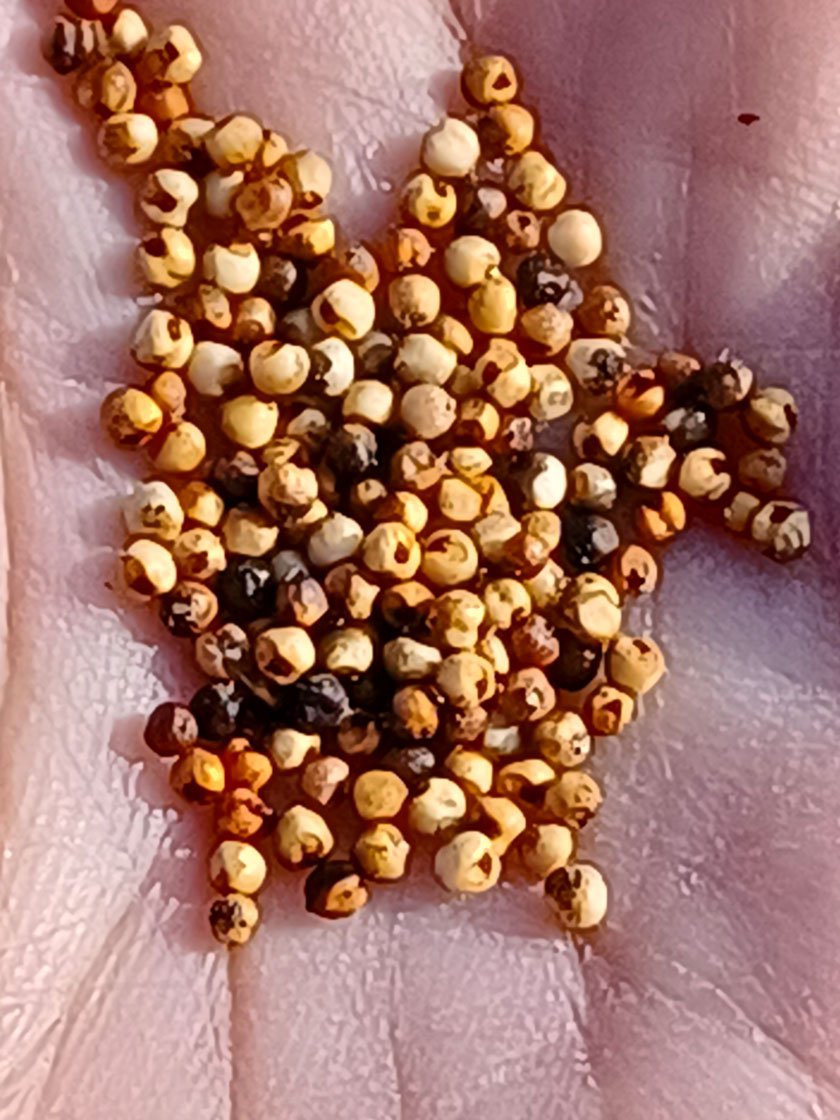
An earhead of the finger millet crop (left) and its grains. Krishnagiri district produces 42 per cent of Tamil Nadu’s ragi
And yet, finger millet has declined in production and popularity. Unsurprisingly, that decline coincided with the rising popularity of rice and wheat with the green revolution – which also saw their easy availability through the public distribution system (PDS).
Ragi production in the kharif season across India has seen fluctuations in the past few years but was thought to be close to 2 million tons in 2021. However, the first estimates for 2022 suggest a decline. The figure for 2010 was 1.89 million tons. The projection – first estimates – for financial year 2022 is around 1.52 million tons.
According to the Dhan Foundation, a development organisation that has worked on millets, “despite their nutritional qualities and climate resilience, the consumption of finger millets in India declined by 47 per cent , while intake of other small millets fell by 83 per cent in the last five decades.
In neighbouring Karnataka, the biggest ragi producer in the country, “the average per capita monthly consumption of finger millet by rural households fell from 1.8 kg in 2004-05 to 1.2 kg in 2011-12.”
The crop survived because some communities and geographies continue to grow and eat ragi . Krishnagiri was one of them.
*****
The more
ragi
you grow, the more cattle you can support, and [so a better] weekly income. People have sold their cattle because of shortage of fodder.
Gopakumar Menon, author and farmer
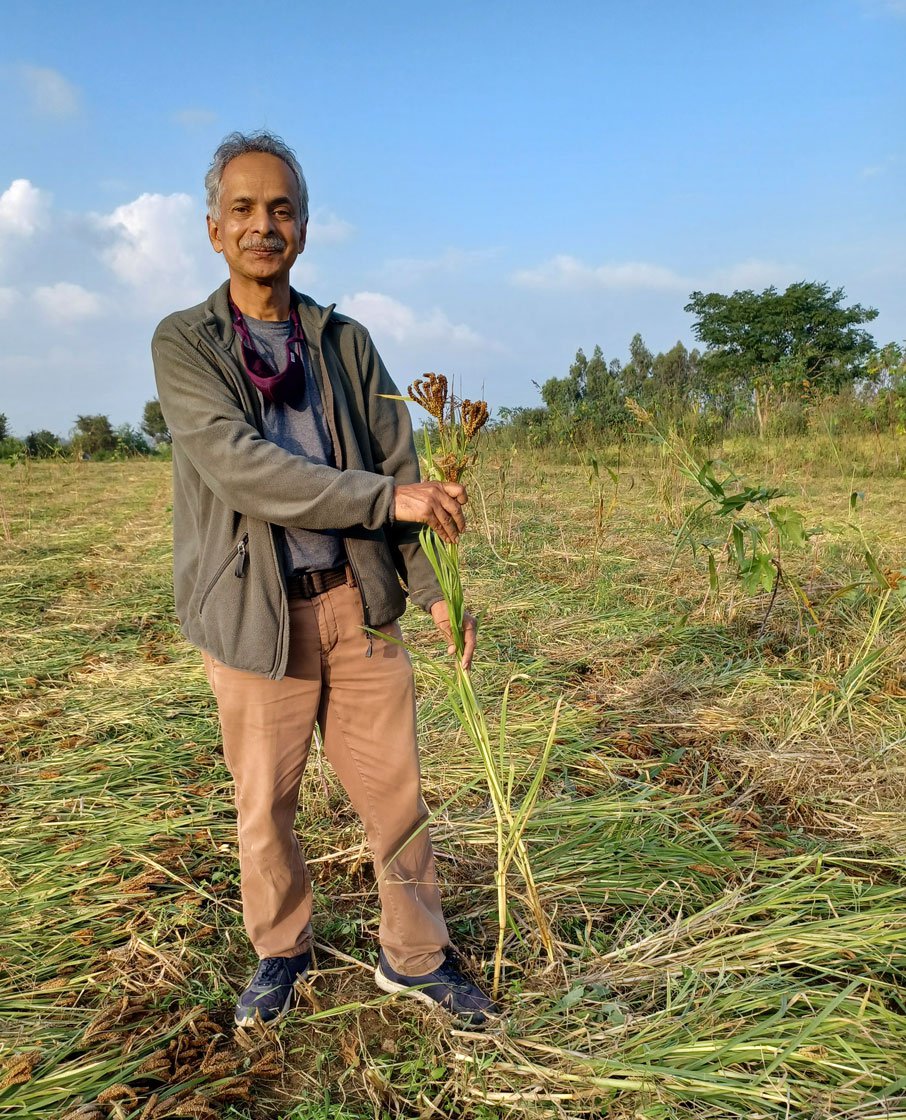
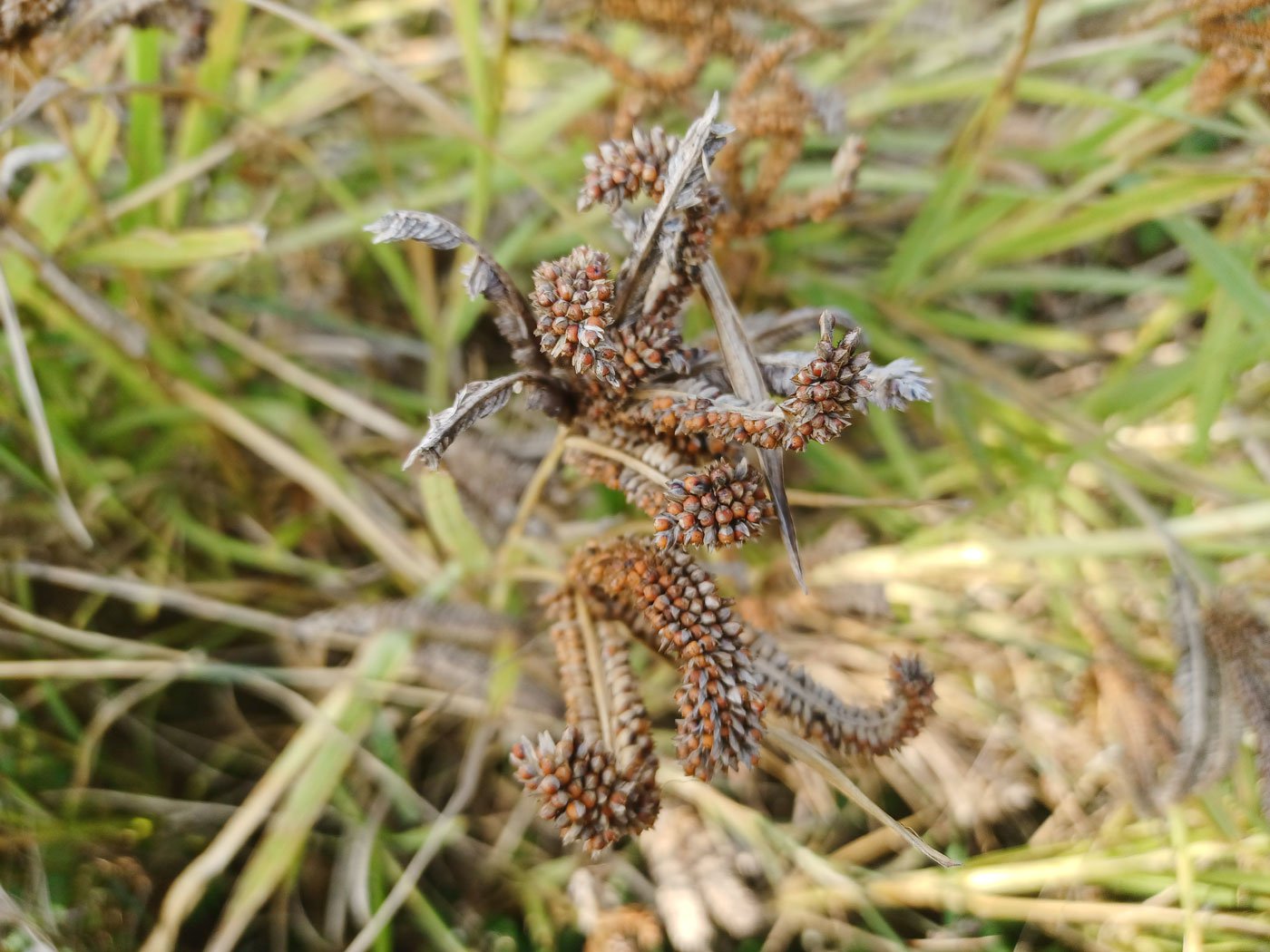
Left: Gopakumar Menon with a
ragi
stalk on his farm in Gollapalli
village. Right: A rain-damaged
ragi
earhead
The night before I visit Naganna’s house, our host in the region, Gopakumar Menon, tells me a thrilling elephant story. It is early December and we’re sitting on the terrace of his house in Gollapalli village. Around us, everything is black and cold and eerily beautiful. Only the small night-life are awake; they sing, they hum, and it is at once reassuring and distracting.
“Mottai Vaal was here,” he says, pointing to the mango tree at a little distance. “He wanted mangoes but couldn’t reach the fruit. So he knocked down the tree.” I look around and everything is elephant shaped. “Don’t worry, if he was here right now, you’ll know,” Gopa assures me.
For the next one hour, Gopa tells me many stories. He is a resource person in behavioural economics, an author, and corporate facilitator. Around 15 years ago, he bought some land in Gollapalli. And he thought he’d farm. Only then did he realise how hard cultivation was. He now sticks to lemon trees and horse gram in his two acres. Full time farmers – who depend on the income – have it much harder. A combination of adverse policy direction, climate change, poor procurement price, and man-animal conflicts has destroyed the traditional ragi crop, he says.
“Finger millets is an excellent example of why the proposed – and repealed farm laws – would not have worked,” says Gopa. “The law said you can sell it to anybody. Take Tamil Nadu. If this were a possibility, farmers would have been growing much more ragi , yes? Why would they smuggle it across to Karnataka, where there is a minimum support price of 3,377 rupees a quintal [against the much lower amount Ananda says he gets here in Tamil Nadu]?”
It turns out that people are not able to realise the support price in this part of Tamil Nadu. Which is why, as Gopa Menon says, some smuggle it across the border.
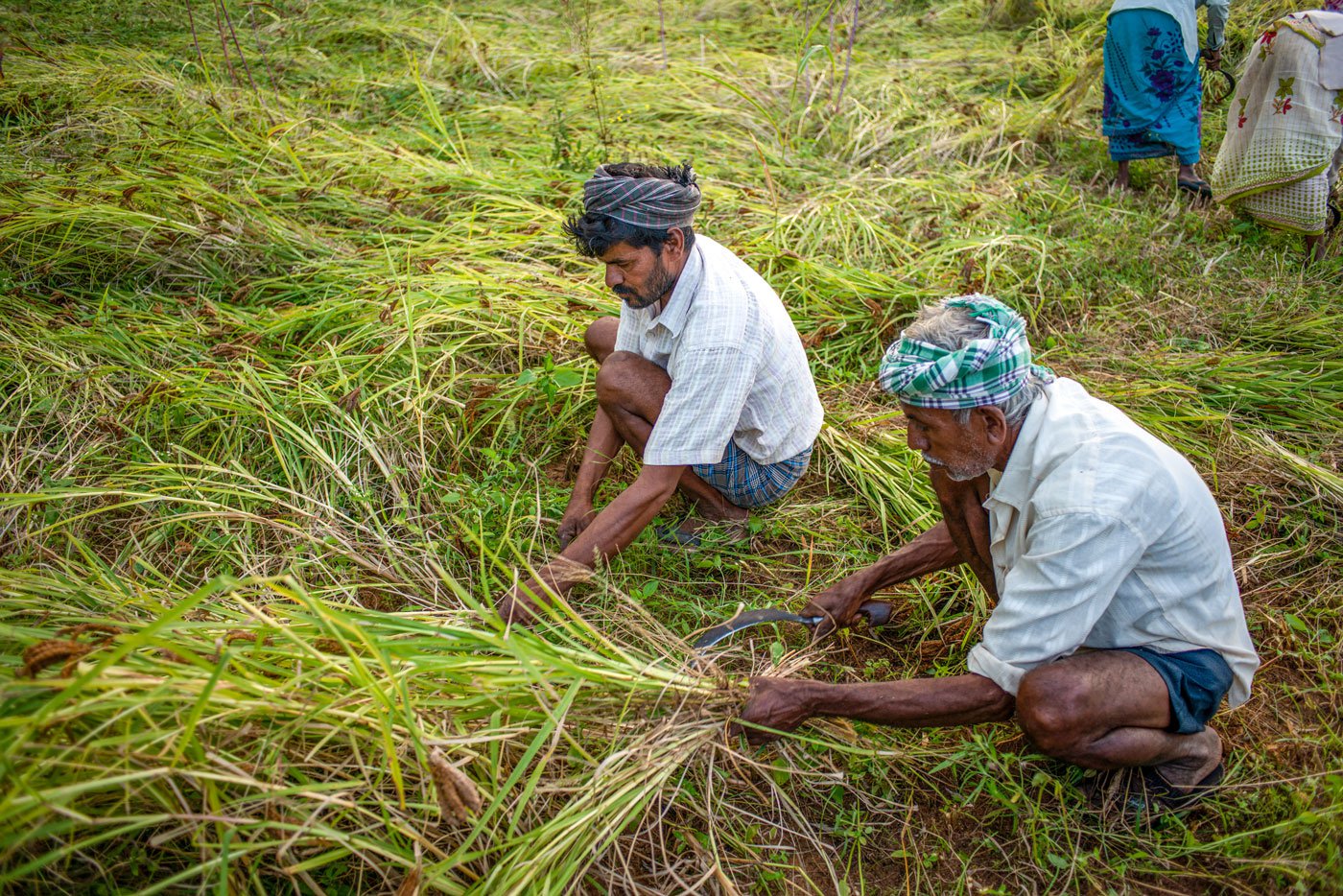
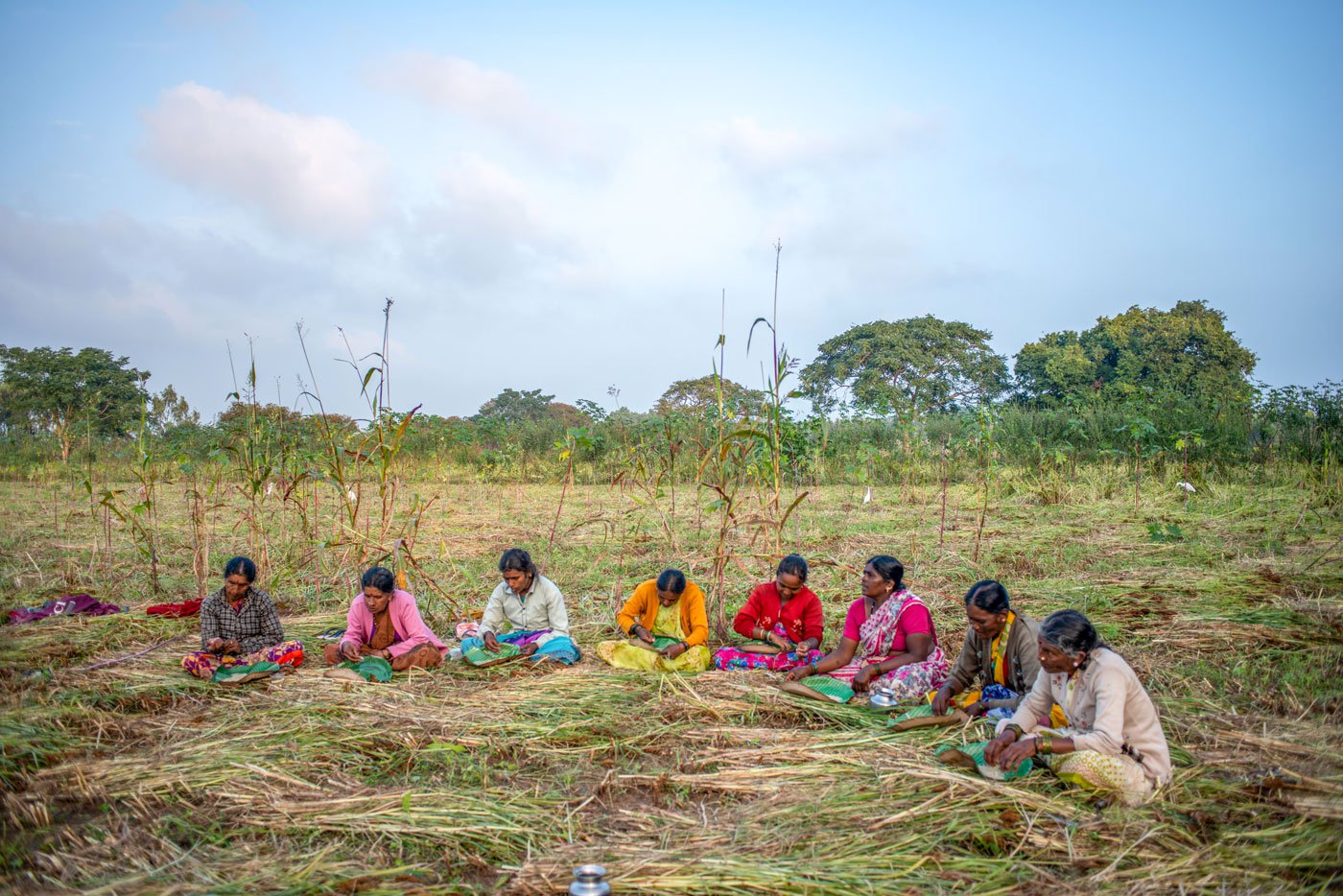
Workers harvesting finger millet crop in the fields leased by farmer Siva Kumaran just outside Gollapalli
Right now, the rate in Tamil Nadu’s Hosur district, says Ananda, is “2,200 rupees for 80 kilos of top quality ragi , and 2,000 for second quality. So effectively, between 25 and 27 rupees a kilo.”
Now this is the price that a commission agent pays them at their doorstep. That man will make his profit – Ananda estimates it to be around 200 rupees a bag – when the ragi changes hands. If the farmers were to go to the mandi directly to sell it, they might get 2,350 rupees for the top quality (for one 80-kilo sack). But he doesn't see any profit in that. “I will have to pay for the loading, the tempo, and the commission at the mandi anyway...”
In Karnataka too, though the MSP is actually realised better than it is in Tamil Nadu, quite a few farmers have been selling at 35 per cent below the support price because of delayed procurement.
“Implement a proper MSP everywhere,” says Gopa Menon. If you buy at 35 bucks a kilo, people will grow it. If you don’t, what’s happening in this area – where people are switching to cut flowers, tomato, and French beans – will become permanent.”
His neighbour in the village, Seenappa, a middle-aged small farmer, wants to grow more tomatoes. “It’s a lottery,” says Seenappa. “Every farmer is influenced by one farmer who made 3 lakhs growing tomatoes. But the input costs are very high. And the price fluctuation is incredible, swinging from a distress sale price of one rupee a kilo to a high of 120 rupees a kilo.”
If Seenappa gets a fair price for it, he would stop tomatoes and grow more ragi . “The more ragi you grow, the more cattle you can support, and you can get more weekly income. People have sold cattle because of shortage of fodder.”
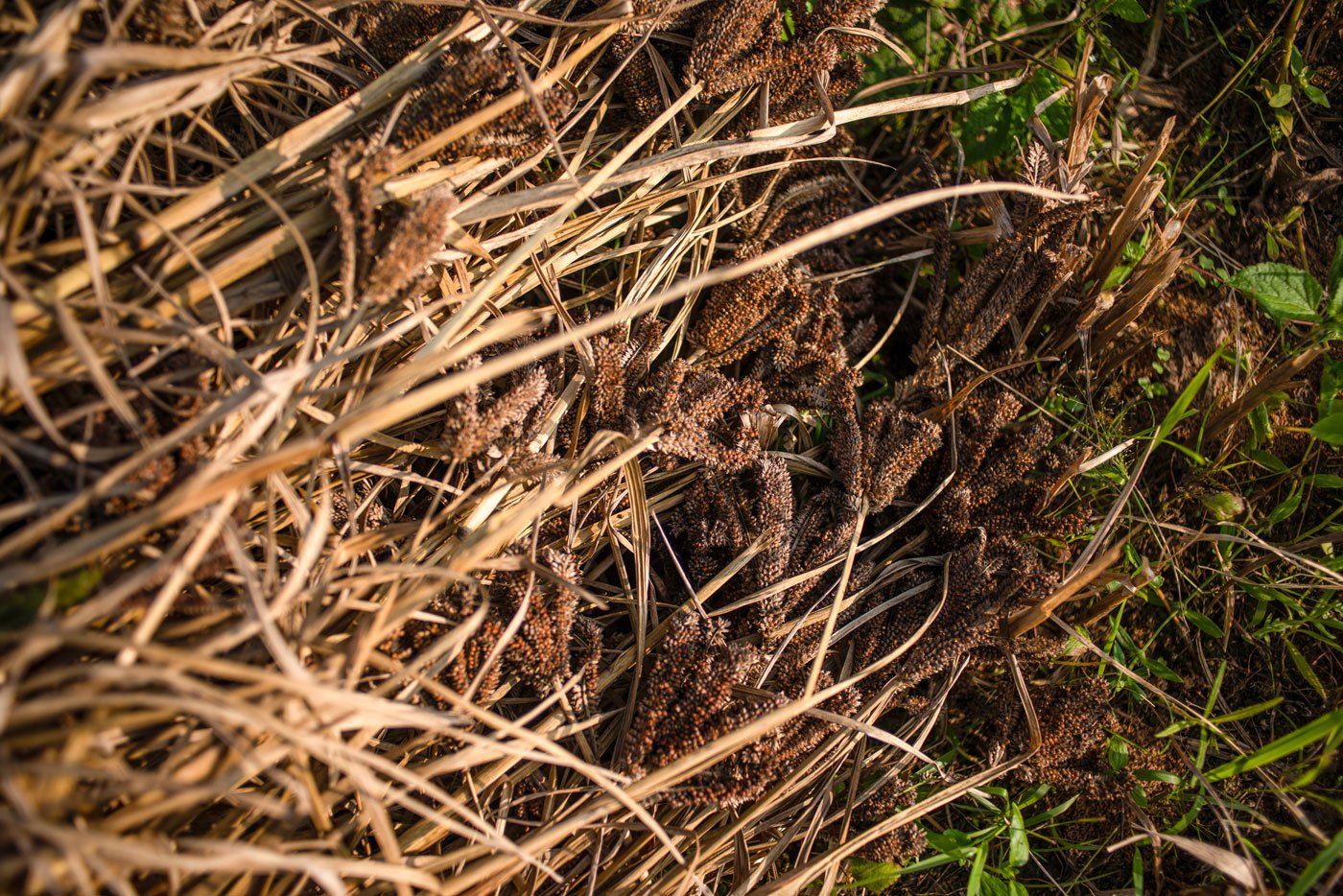
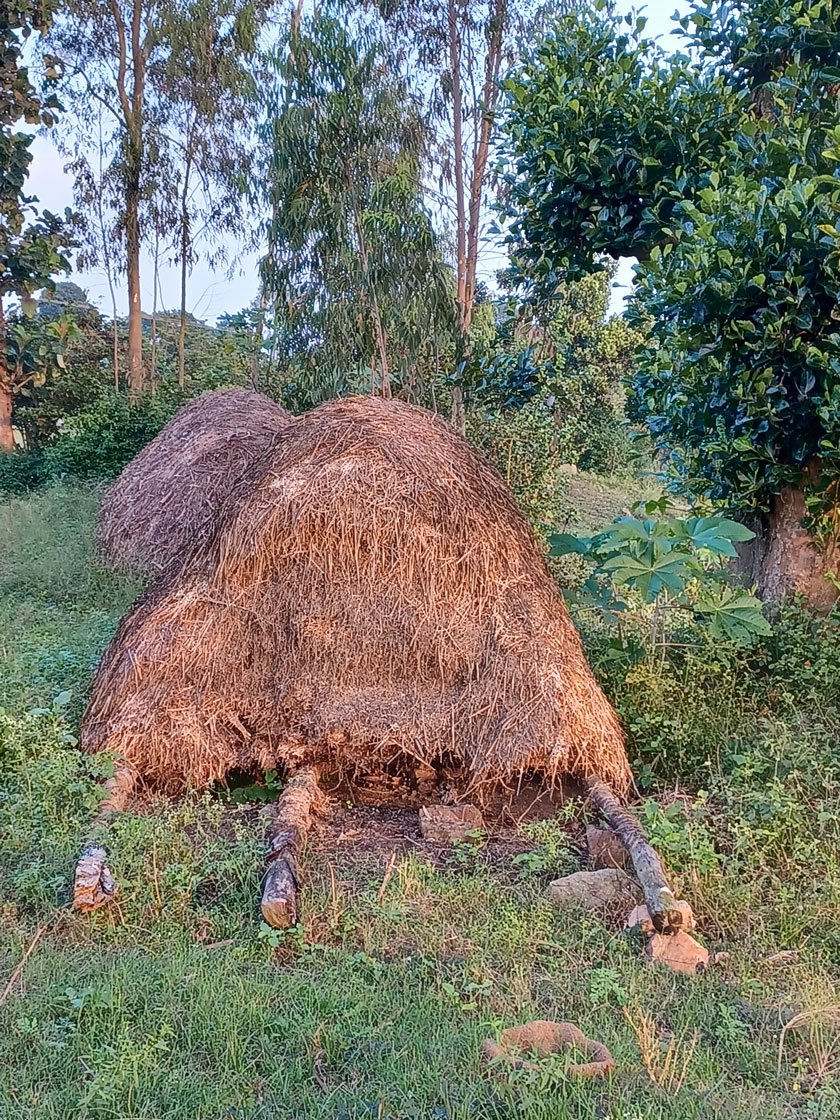
Left: Harvested
crop tied in a bundle.
Ragi
grains can be stored for up to two years. Right: The stalks are stacked and used as livestock fodder
Ragi is the staple diet for all the people here, Gopa Menon tells me. “You sell ragi only if you need cash. It can be stored for up to two years and ground when required, and eaten. Other crops do not keep that well. Either you hit the jackpot today, or you’re finished.”
The conflicts in the area are many and they’re complex. “Cut flowers grown here go mainly to the Chennai market,” says Gopa Menon. “A vehicle comes to the farm gate and you get your payment. Whereas for ragi , which is the most valuable of crops, there is no assurance, and it is the same price for native variety, hybrid or organic.”
“Richer farmers have put electric fences and walls and diverted elephants into the poorer farmers’ regions. Richer farmers are growing something else. Poorer cultivators are growing ragi .” And yet, Gopa continues, “farmers here are incredibly tolerant of elephants. Their issue is that the amount they eat is just a tenth of the damage that is caused. I have seen Mottai Vaal 25 feet away,” he says, and the elephant stories become vivid again. “Like the people, Mottai Vaal belongs to more than one state. He is a resident Tamilian. He is also an honorary Kannadiga. Makhana is his deputy. He shows Makhana how to cross the electric fence.”
Quickly, it feels as if Mottai Vaal is right next to the terrace, listening. “Maybe I will go to Hosur and sleep in the car,” I laugh nervously. Gopa is amused. “Mottai Vaal is a massive fellow, he’s huge,” he says, drawing out vowels for effect. “But he is a very gentle guy.” I pray I don’t meet him – or any other elephants – anytime soon. But the gods have other plans…
*****
With the original native
ragi
, yield was low, but the taste and nutrition was high.
Nagi Reddy,
ragi
farmer in Krishnagiri
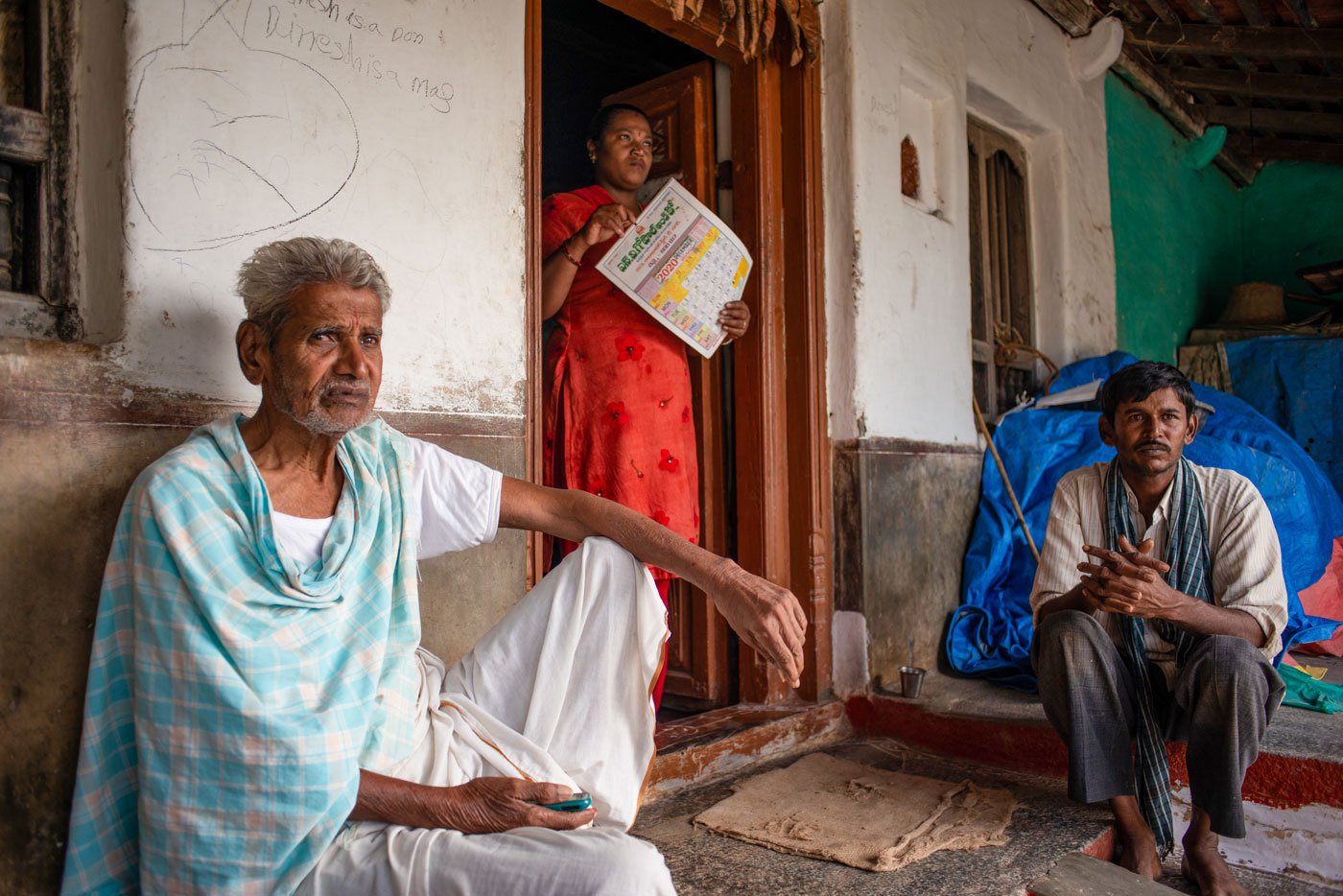
From left: Naganna (Nagi Reddy), his daughter-in-law Prabha and son Ananda at the verandah of their home in Vadra Palayam hamlet. Naganna says, “I remember five varieties of ragi ”
When Naganna was a young man, the ragi grew as tall as his chest. He is a tall man – close to 5 feet and 10 inches – and thin. He wears a dhoti and vest, with a towel wrapped around his shoulders. He carries a stick sometimes, and for social visits, puts on a spotless white shirt.
“I remember five varieties of ragi ,” he says, sitting on his verandah, observing the village, the house, and the courtyard, all at once. “The original naatu ( native ) ragi had only four or five fingers. The yield was low, but the taste and nutrition was high.”
Hybrids, he recalls, made an appearance in 1980. They had initials as names – MR, HR – and they had more fingers. The harvest went up, from five sacks of 80 kilos each, all the way to 18 sacks. But an improved yield does not necessarily excite the farmers – because the price is not high enough for them to cultivate it commercially with corresponding income benefits.
In the 74 years he has farmed – he started when he was 12 – Naganna has raised many crops. “Our family grew everything we wanted. We made jaggery from sugarcane in our fields. We grew sesame and pressed the seeds in a wooden mill for oil. Ragi , rice, horse gram, chilli, garlic, onion…we had everything.”
The farm was his school. The formal one was far off and not accessible. He also looked after the family’s livestock, which included cattle and goats. It was a busy life. There was work for everybody.
Naganna’s joint family was large. All of them – he counts up to 45 members – lived in the big house that his grandfather built. It’s right across the lane, a 100-year-old building with a cattle shed and old bullock cart, and granaries built into the verandah to store the annual ragi crop.
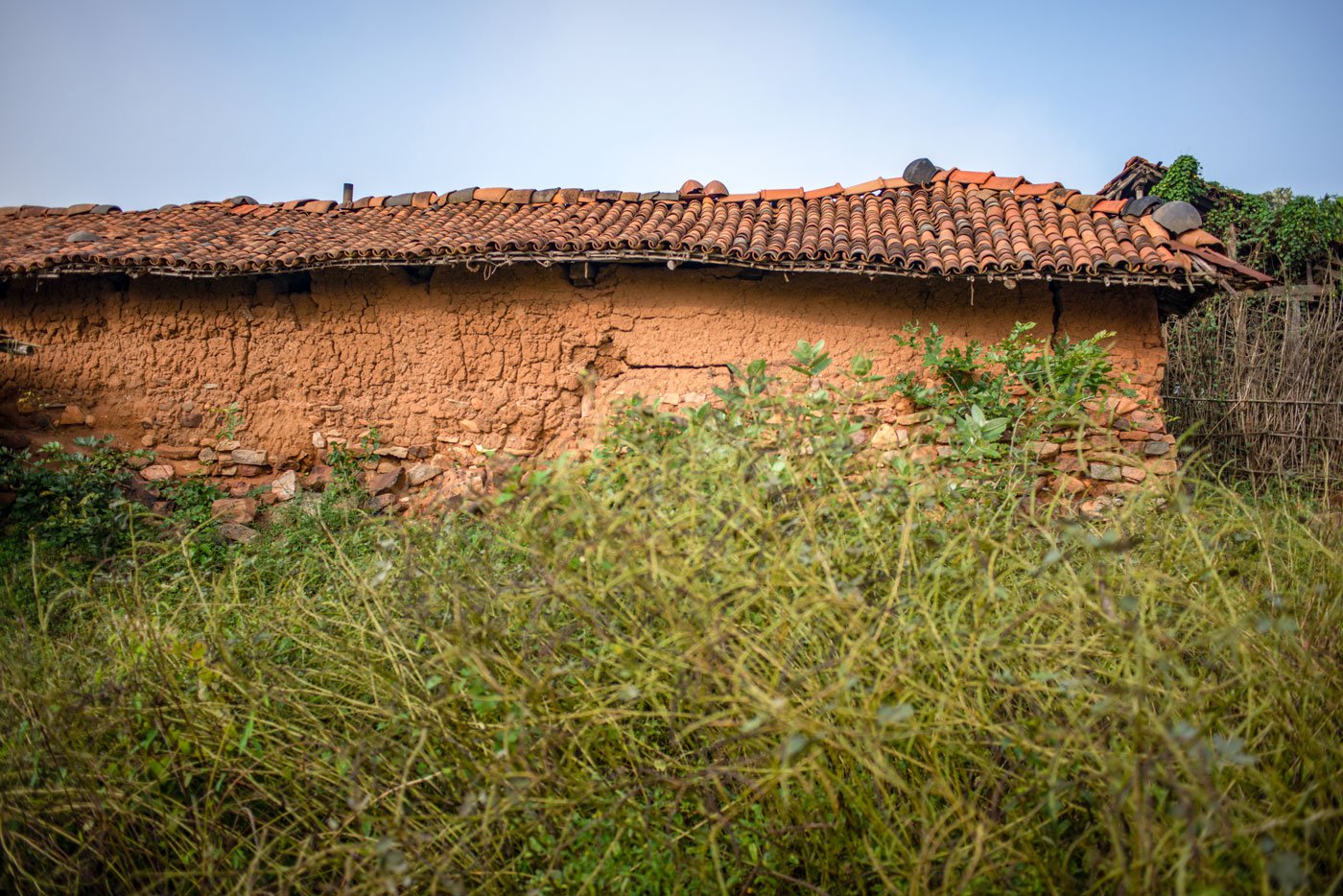
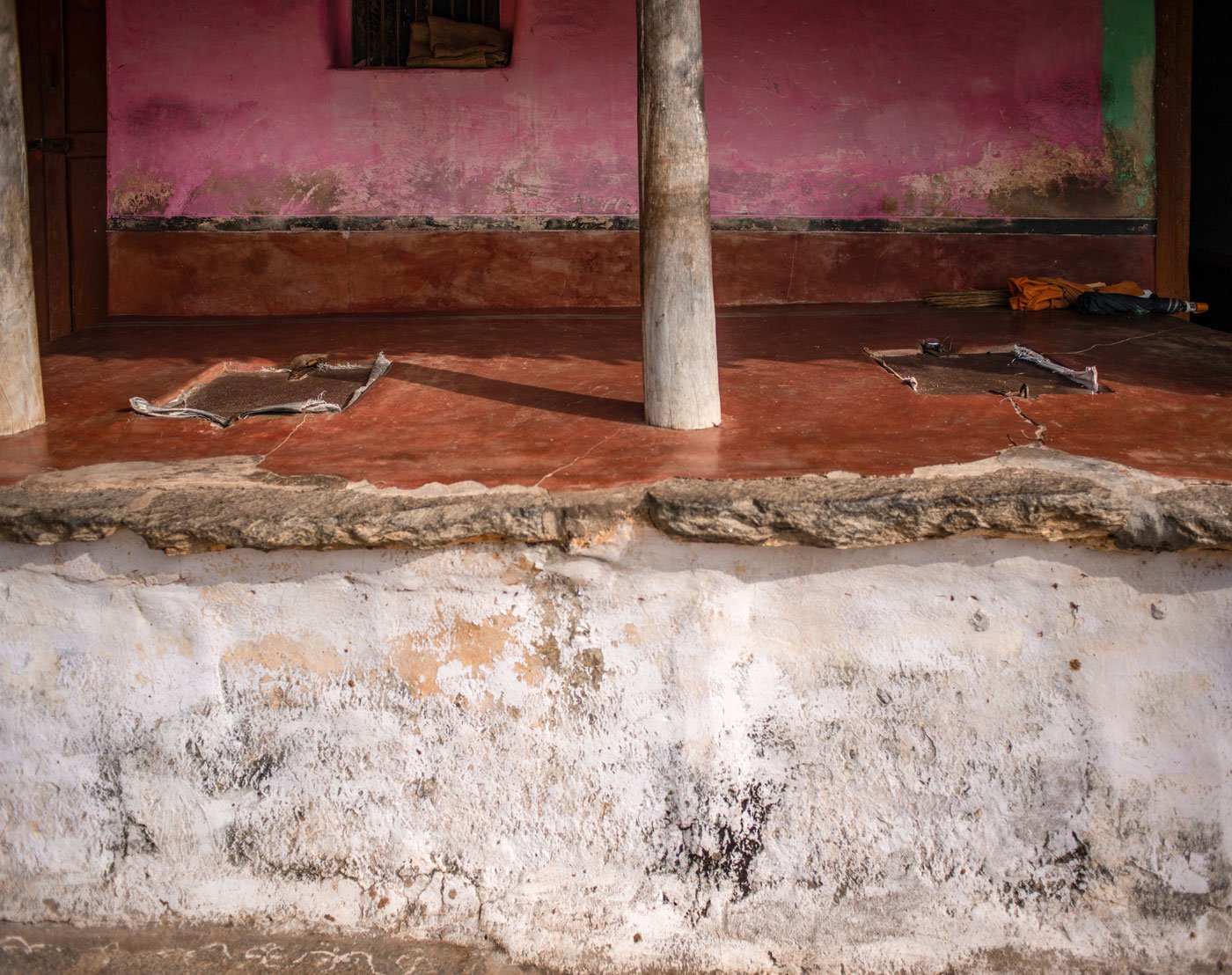
Left: The cattle shed of Naganna’s ancestral house. Right: Verandah of the old house with the granary built into it
When he was 15, Naganna’s family split the property amongst its many members. He got, apart from a share of land, what was then the cowshed. And it was his lot to clean it and build a house. “Back then, each bag of cement cost 8 rupees – very big money. We made an oppandam [agreement] with a mason to build this house for 1,000 rupees.”
But it took years to complete. The sale of a goat and 100 blocks of jaggery bought some bricks to add a wall. The material came in a maatu vandi (bullock cart). Money was tight back then. After all, ragi only fetched 8 annas for a padi , (a traditional measure in this state – 60 padis made 100 kilos).
A few years before he got married – in 1970 – Naganna finally moved into his house. He’s not added any modern touches, he says, “just a little here and there.” His grandson did his bit. With a sharp tool, he’s carved his own name and preferred designation above the perai (ledge for the oil lamp): ‘Dinesh is the don.’ We had seen the 13-year-old earlier that morning – walking down the road to his school, looking more good-boy than don – and he had mumbled hullo and fled.
The wannabe don’s mother, Prabha, serves us tea. Naganna asks her to fetch horse gram. She brings it in a tin dabba, and it makes a kind of music when she shakes it. He explains how it is cooked in a kozhambu (gravy). Eat it raw, he says, “ paravayilla [it’s okay].” We all have a handful. It is nutty, crunchy and delicious. “Roasted and salted it tastes very good,” Naganna says. We don’t doubt it at all.
What has changed in agriculture, I ask him. “Everything,” he says bluntly. “Some changes are good, but people,” he shakes his head, “no longer want to work.” At 86, he still goes to the field daily and has a clear understanding of the everyday issues as they affect him. “Now, even if you have land, you don’t get labourers,” he points out.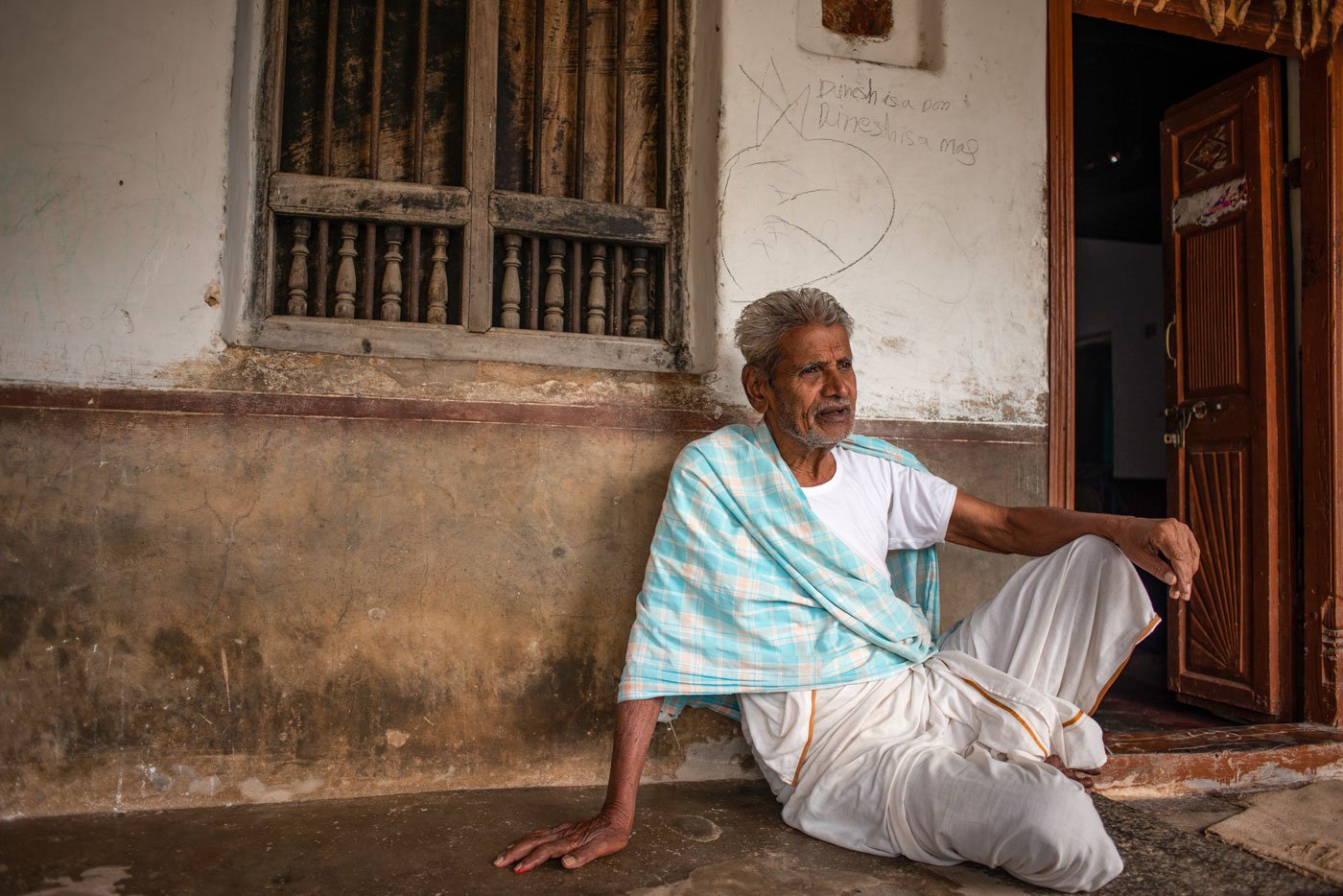
Sitting on the verandah of his house, Naganna narrates stories from his younger days
“People will tell you there are machines to harvest ragi ,” says Ananda, “but the machine cannot differentiate between the fingers. From a single kadhir [stalk], one finger might be ripe, another might be dry, yet another will be milky. The machine will rip them all together. When it is bagged, it will go waste and smell all mouldy.” Processing it by hand is laborious, “but it keeps for much longer.”
Fifteen women were harvesting – by hand – Siva Kumaran’s leased ragi field. With his sickle tucked under his armpit, and towel draped over his T-shirt printed with the words ‘Superdry International’, Siva spoke passionately about ragi .
Just outside Gollapalli, his field had seen much rain and wind the previous weeks. Siva, 25, is a keen farmer, and tells me about the wet days and wretched loss of yield. The stalks had fallen in different directions, and the women squatted, scythed, and stacked the ragi into bundles. The yield has gone down, he points out, while the woman-hours to harvest have shot up from one to two days. The lease price of the land, however, remains unchanged.
“For this field – less than two acres – I need to pay seven sacks of ragi for the lease. The remaining 12 or 13 I can keep or sell. But,” he asserts, “you can see a profit only with Karnataka prices. We need 35 rupees a kilo in Tamil Nadu. Write that down,” he instructs me. I make a note…
Back in his yard, Naganna shows me the old rolling stone. It is a huge cylinder, which was drawn by cattle over the harvested ragi , spread over hard ground specially prepared with cow dung. Slowly, but efficiently, the stone crushed the fingers, the ragi and stalks were collected separately. The millet would then be winnowed and stored in the pits in front of the house. Earlier, they used to be bagged in jute sacks – and now in white plastic.
“Now come inside,” Naganna invites us. “Have a meal…” And hoping to hear some stories in the kitchen, I eagerly follow Prabha.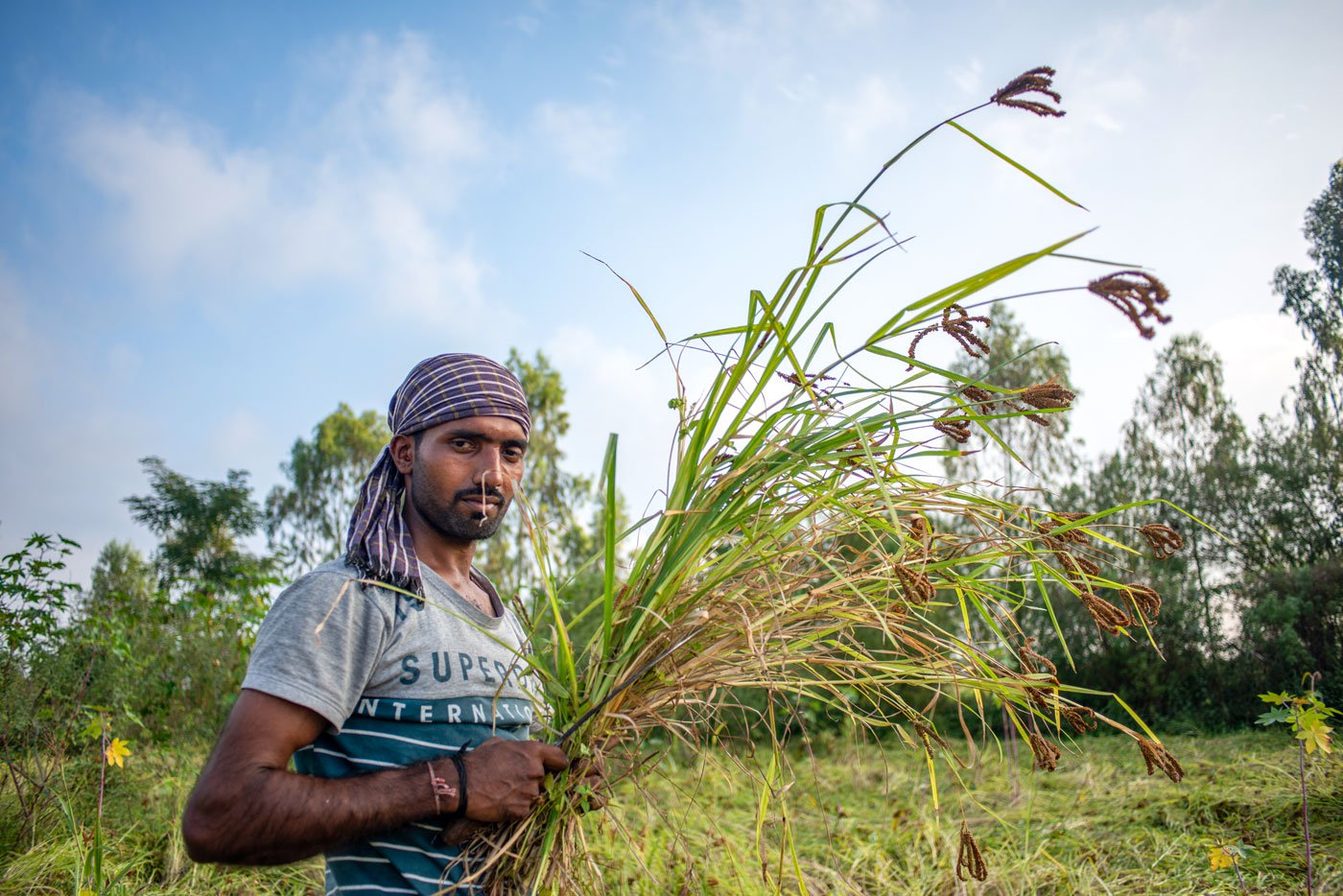
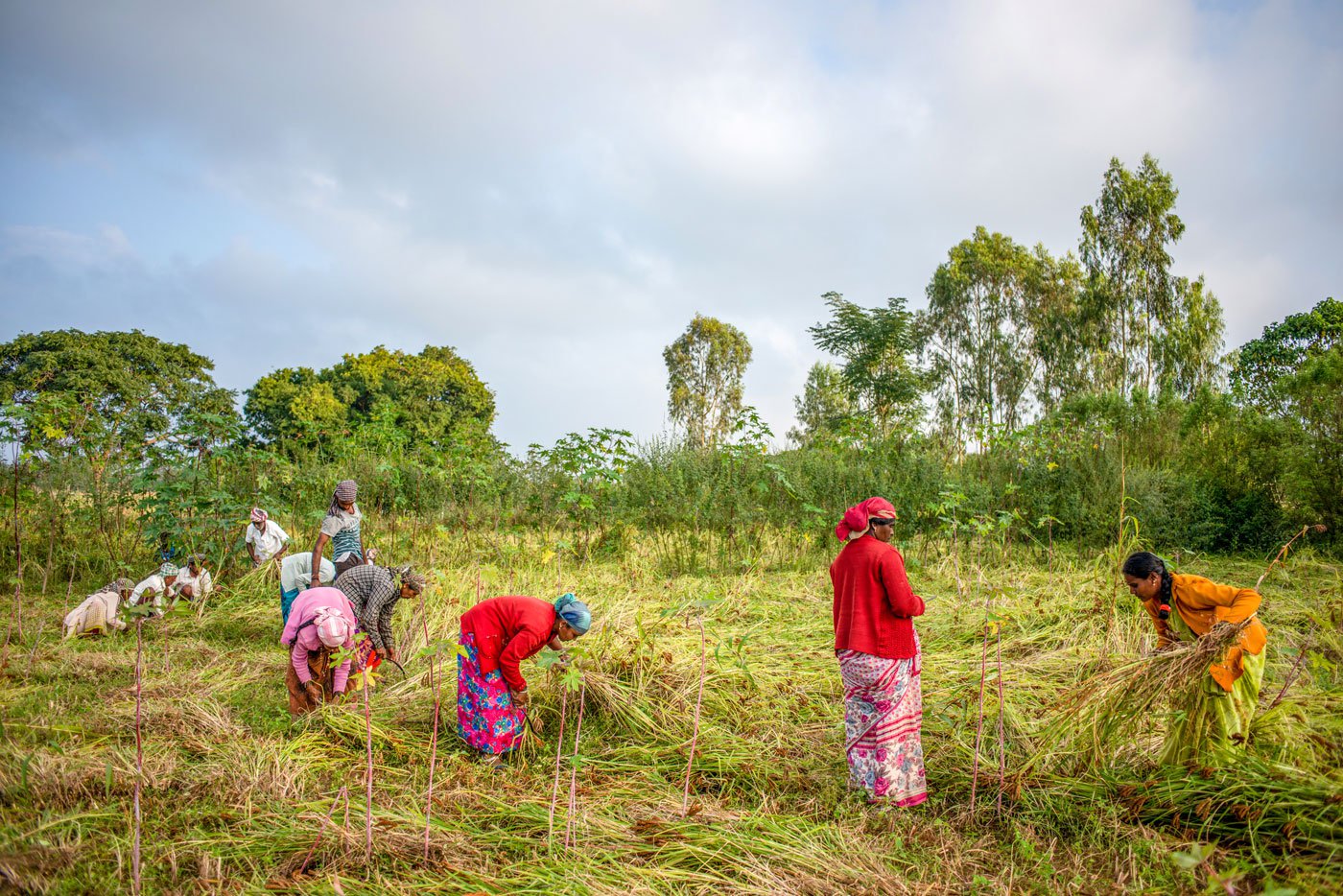
Left: Siva Kumaran harvesting the rain-damaged
ragi
crop on his leased land outside Gollapalli. Right: Workers cutting and bundling the stalks in Siva's field
*****
Pigeon-egg like finger millet grains
Grown in rain fed fields
Cooked in milk and mixed with honey
And fire cooked meat of fleshy rabbit,
I eat with my kith and kin
‘Puranaanooru 34’, Sangam poem by Alathur Kizhaar
Translated by Chenthil Nathan
High in calcium and iron, gluten-free, and with a long shelf life – up to two years – ragi is a healthy cereal. Even 2,000 years ago, the Tamils had an interesting millet recipe with meat and milk and honey. Today, ragi is cooked and eaten as a meal, made into snack, and fed to babies. Many regions of Tamil Nadu have their own recipes. In Krishnagiri, it is the ragi mudde (ball), also called kali , as Prabha demonstrates.
We are in her kitchen, where the steel stove sits on a cement platform. She pours water into an aluminium kadai (a round pot). And she waits with a wooden stick in one hand, and a cup of ragi flour in the other.
Can she speak Tamil? I ask, initiating a conversation. Dressed in salwar kameez , wearing little jewellery and a small smile, she shakes her head. But she understands the language, and answers haltingly in Kannada laced with a little Tamil. “I’ve made this for the last 16 years,” she says. Since she was 15.
Her experience shows when the water begins to boil. She adds a big cup of ragi flour into it. It turns into a greyish paste. Holding the pan with tongs, she briskly stirs the mixture with the wooden stick. It’s heavy work – and calls for skill and stamina. The ragi cooks in a few minutes, the dough rolls around the stick like a ball.
It is interesting to reflect, as I watch her, that women here have probably done this for a couple of thousand years.
“When I was young, this was made in a mud pot, over a wooden fire,” Naganna explains. The taste was superior, he promises. Ananda puts that to the native variety they ate then. “The smell greeted you outside the house. Gama gama vaasanai ,” he says, qualifying the native ragi ’s fragrance as exceptional. “With the hybrids, the smell does not even come to the next room!”
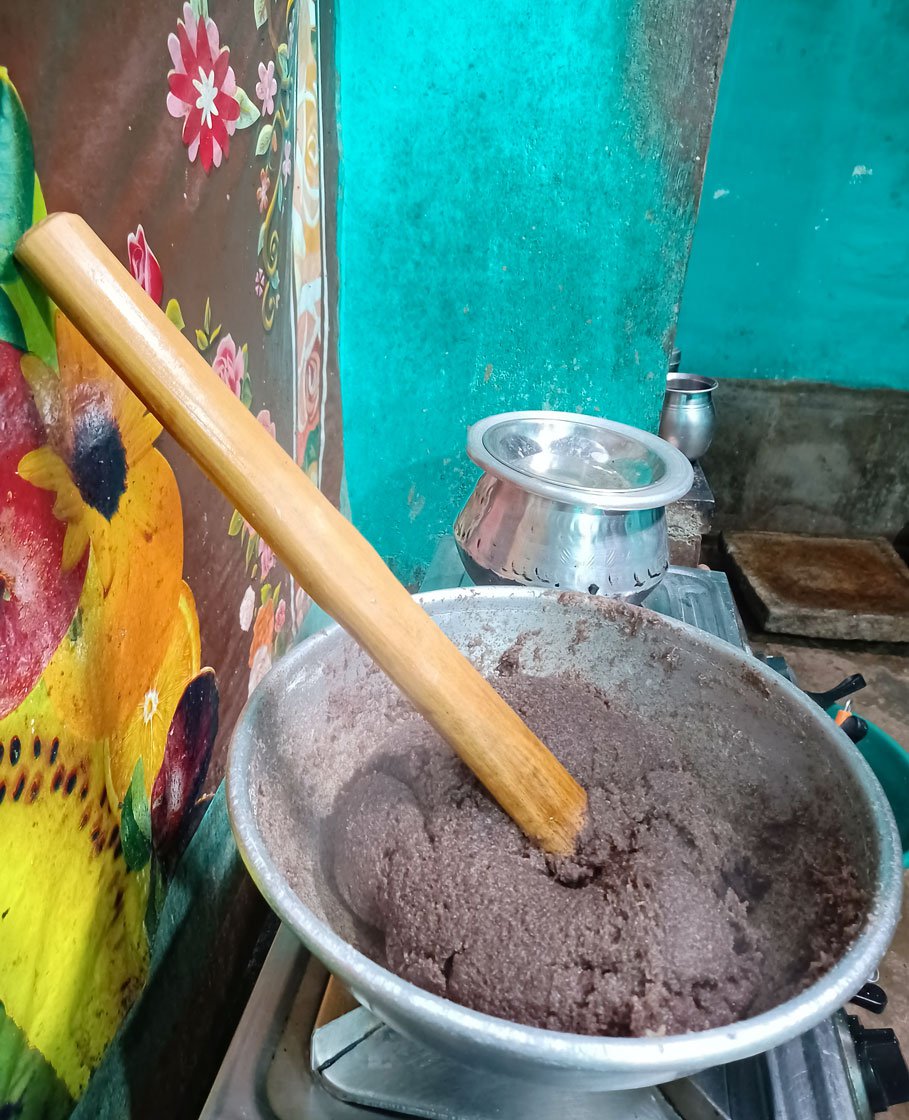
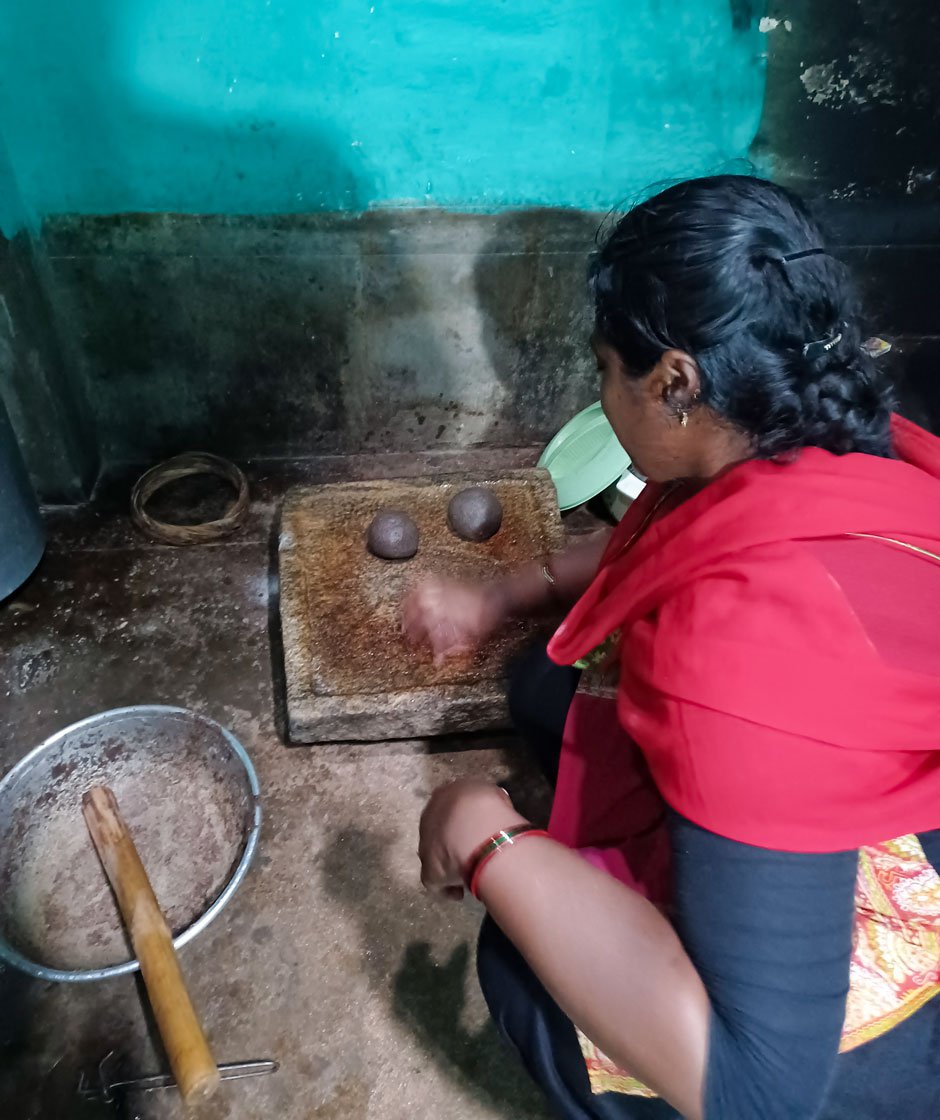
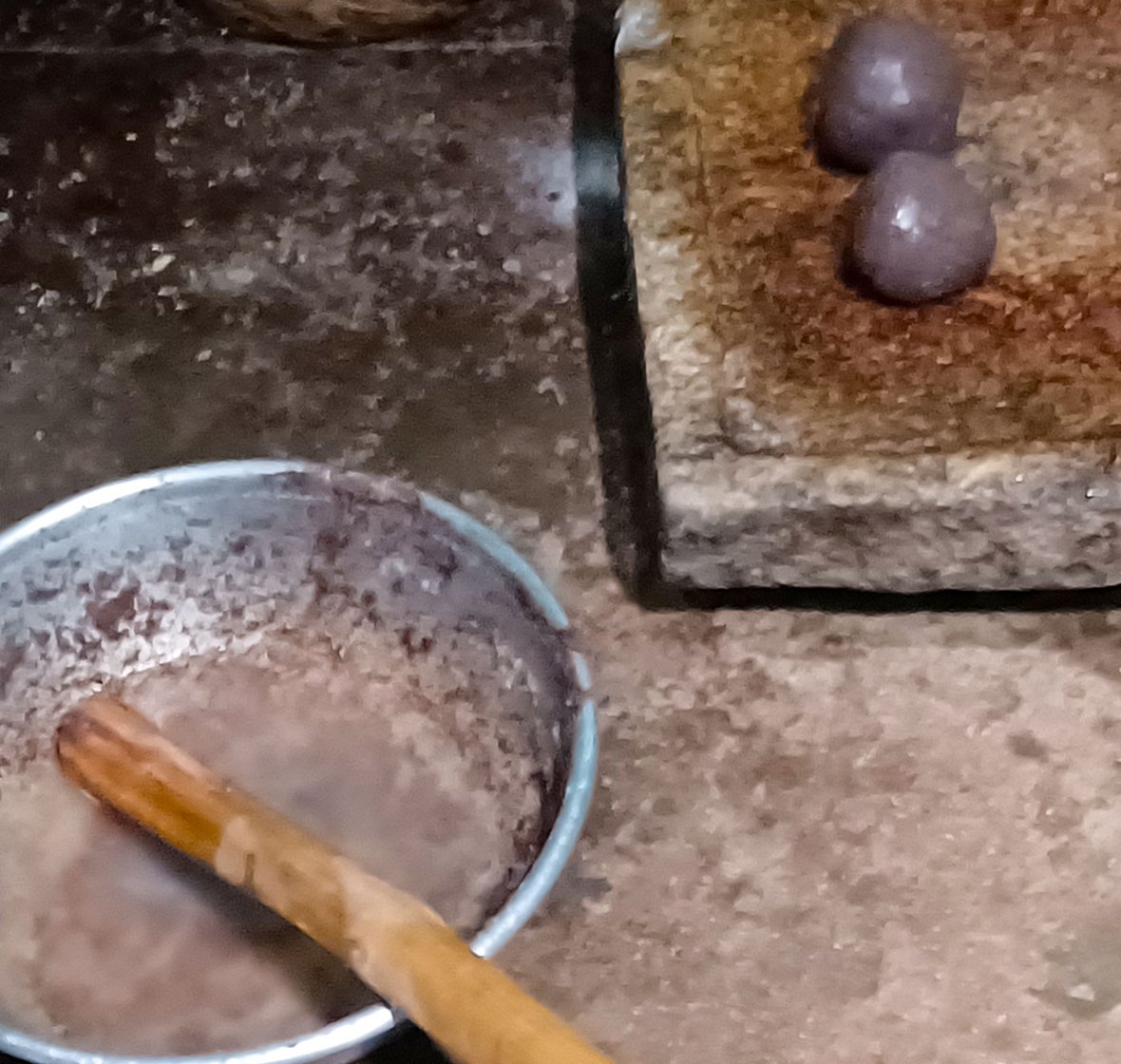
Left:
Ragi
dough cooked by Prabha. Centre and right: Prabha making mudde (balls) by rolling the hot dough with her palm on a granite slab
Perhaps because her in-laws are present, Prabha talks very little. She takes the kadai to a square granite stone in a corner of the kitchen and transfers the steaming ragi dough on it. With her palm, she deftly rolls the hot, hot dough it into a thick tube. Dipping her hand into water to moisten it, she pinches the ragi into a big piece and shapes it between her palm and the stone into a ball.
When she’s made a few, we are served our meal on steel plates. “Here, eat it like this,” Naganna says, pinching my ragi mudde into small pieces and dipping it into the horse gram gravy. Prabha brings us sautéed vegetables in a cup. It is a delicious meal and keeps us full for hours.
In nearby Bargur, also in Krishnagiri district, ragi is made into rotis by the Lingayat communities. During a long-ago visit, farmer Parvati Siddhaiah had cooked it for me in a rough and ready outdoor stove. Thick and tasty, the rotis kept for many days, and were a staple meal for the family’s herders when they took the cattle and went into the forest to graze.
Chennai-based food historian, raconteur and show host Rakesh Raghunathan, describes an heirloom family recipe: ragi vella adai . A sweet pancake, this dish calls for ragi powder, jaggery and coconut milk, and a pinch of cardamom and dry ginger powders. “My mother's grandmother taught her this adai . It was made in the Thanjavur region, and it was traditionally eaten to break a fast, on the day of the Karthigai Deepam [a traditional festival of lights].” These plump pancakes made with a little ghee are both nourishing and soothing, an ideal post-fast meal.
In Pudukottai district’s Chinna Veeramangalam village, the famous chefs of the Village Cooking Channel rustle up a ragi meal: kali with karuvaadu (dried fish) . The USP of their YouTube channel is reviving traditional recipes. “ Ragi was cooked and eaten widely until I was seven or eight. Then it vanished, and rice slowly appeared,” Subramanian, 33, a co-founder of the channel, says over a telephone interview.
The two-year-old video with nearly 8 million views – not surprising given the channel’s whopping 15 million subscribers – documents every step, from grinding the ragi with a granite stone, to eating it out of a palm leaf cup.
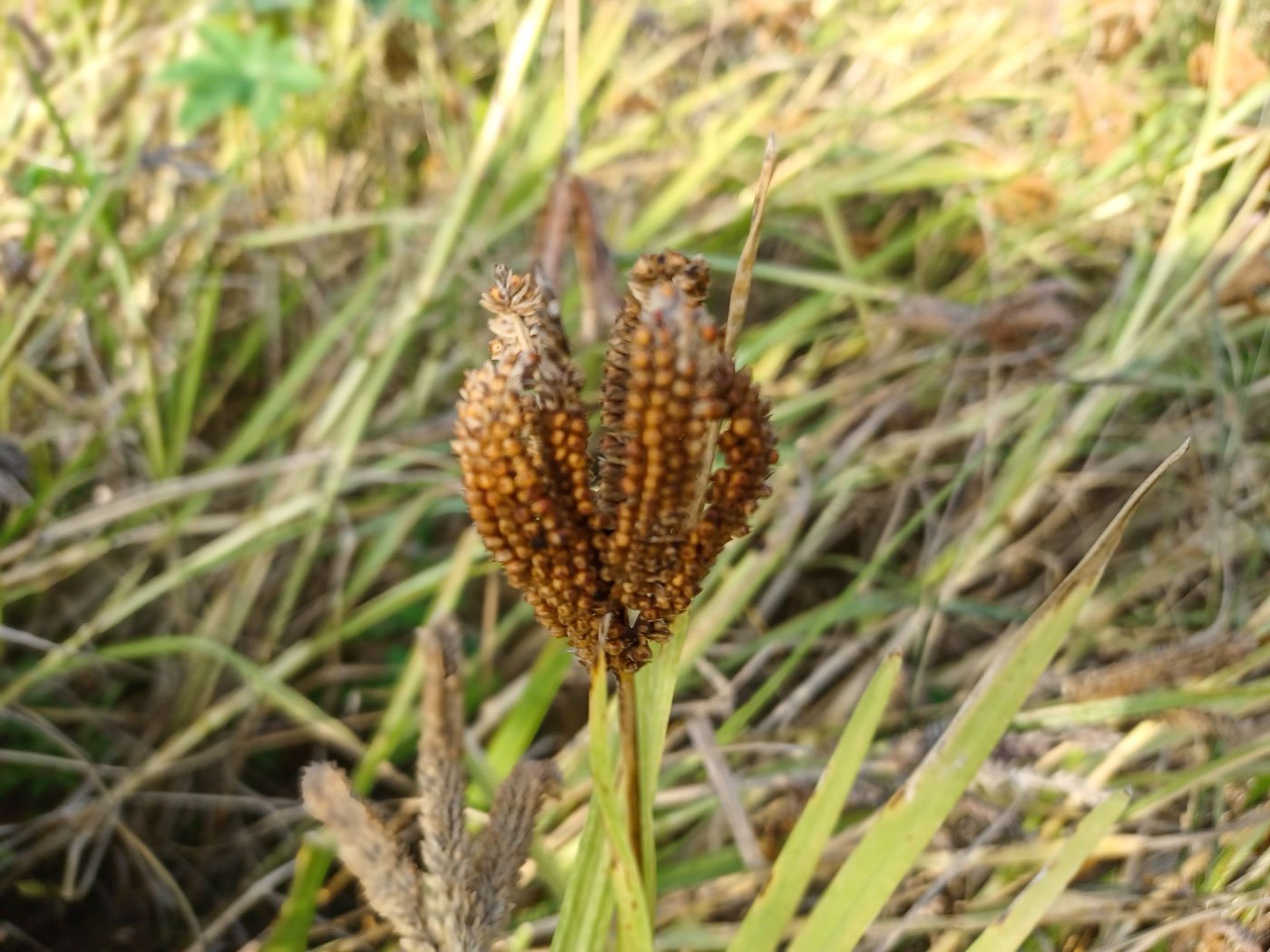
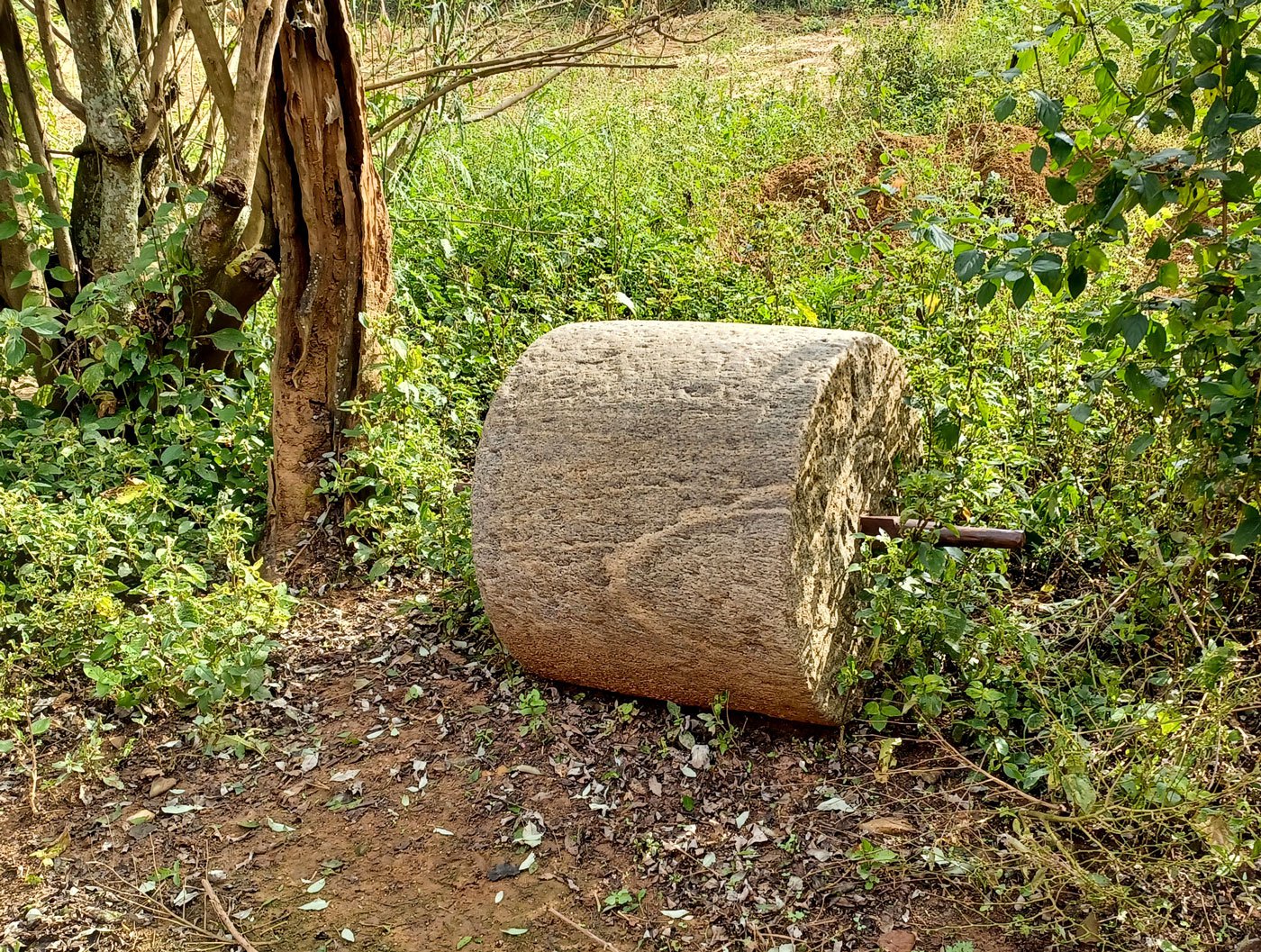
Left: Consumption of finger millet has been declining in the last five decades. Right: The
threshing stone in Naganna's yard that used to be drawn by cattle
The most interesting segment is cooking the ragi mudde . Subramanian’s grandfather, 75-year-old Periyathambi, supervises mixing ground finger millets with a handful of cooked rice, making it into balls, and dropping them into rice water. This salty version is eaten with dried fish, which are slow roasted over a wood fire, until the skin is charred and flaky. “An everyday meal would simply be accompanied by shallots and green chillies,” he points out.
Subramanian speaks passionately about native varieties of rice and the nutritive value of millets. He and his brothers and cousins impressed Rahul Gandhi on a visit to Tamil Nadu before the 2021 assembly elections. And with each video, their cooking channel spotlights – and often revives – dishes that are on the brink of disappearing.
*****
Those farmers who keep spraying chemicals donate their profits to the hospitals.
Anandramu,
ragi
farmer in Krishnagiri
The disappearance of ragi from the farmlands around Naganna’s hamlet is down to three factors: economics and elephants, and a recent, more pressing one: climate change. The first one is true for all of Tamil Nadu. The input costs for an acre of finger millet varies between 16,000 to 18,000 rupees. “If there’s rain or elephant raids, everybody is on the look-out for labourers during the harvest, and it adds another 2,000 rupees to the cost,” Ananda explains.
“The selling price in Tamil Nadu is 2,200 rupees for an 80-kilo sack. That’s 27.50 rupees a kilo. You can get up to 15 sacks in a good year – 18, if you use high yield seeds. But,” Ananda warns, “the cattle don’t care for the stalk of hybrids. They only like the native variety.”
And that’s an important rider, because one load of ragi stalk sells for 15,000. And you can get up to two loads from an acre. Farmers with livestock use it to feed their animals. They store it in a heap, and it keeps nicely for over a year. “We don’t sell the ragi too,” Ananda points out, “until we get a good crop the next year. It’s not just us, even our dogs and chickens eat only millets. We need enough to feed everybody.”
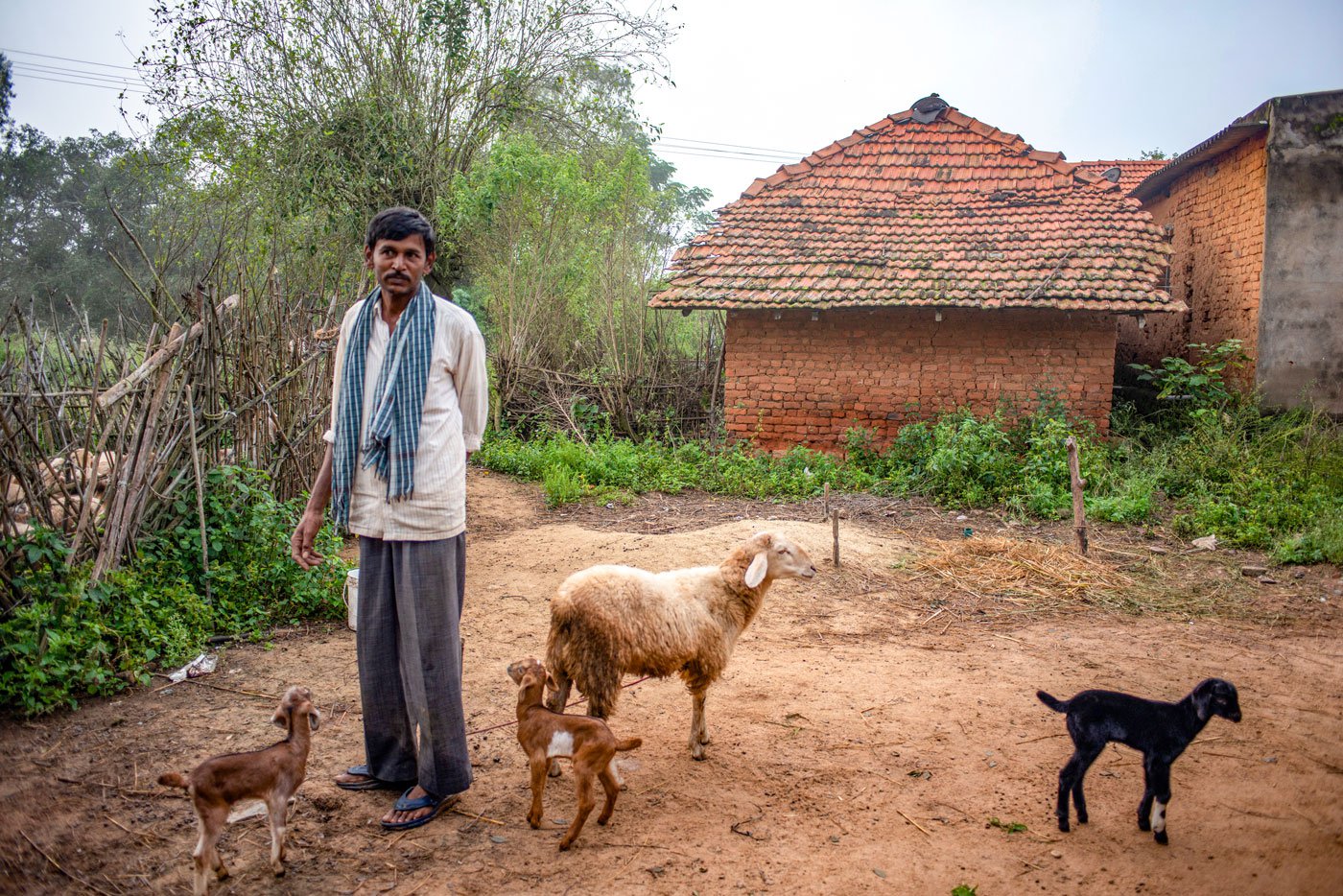
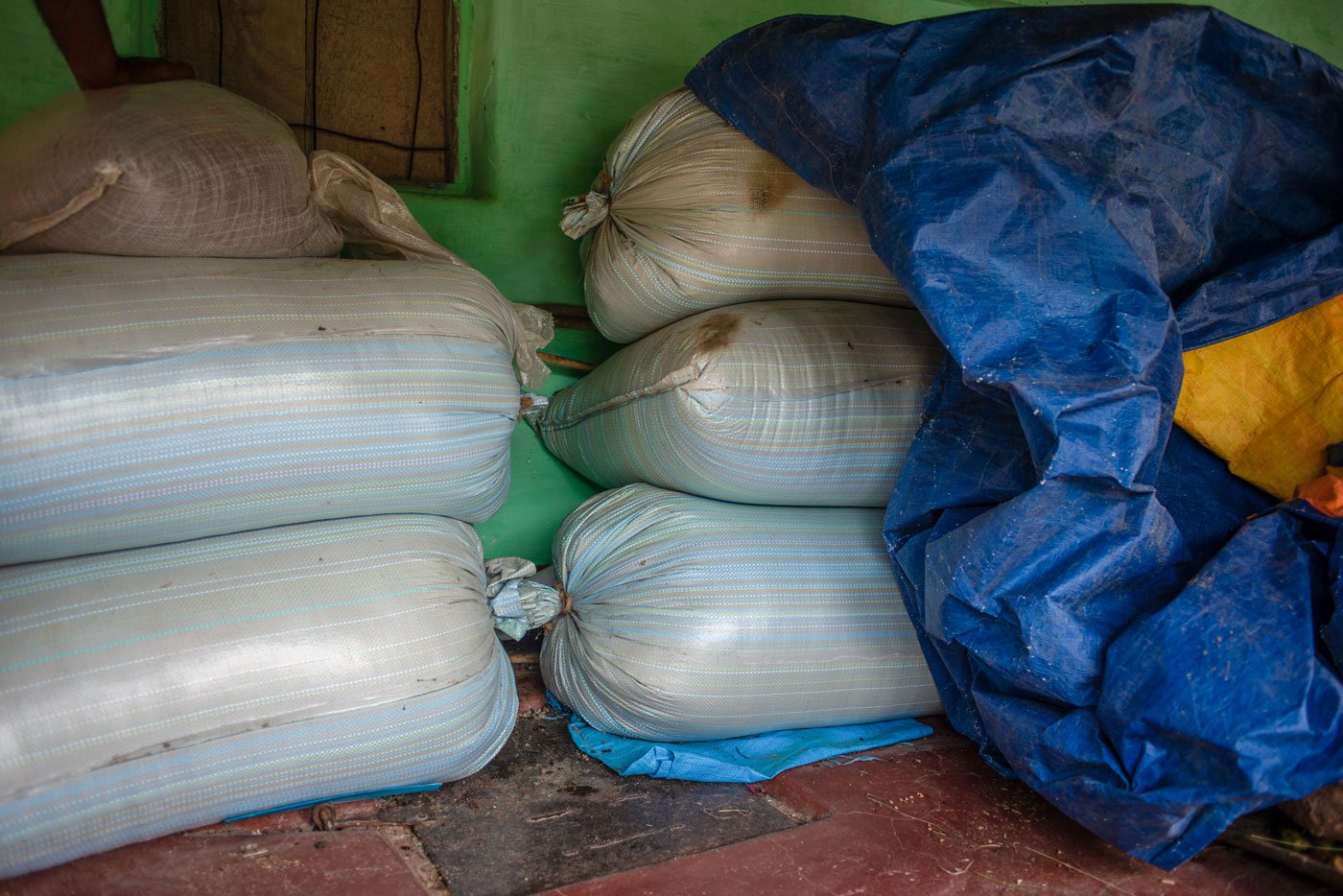
Left: Ananda with his sheep and goats; the animals feed on ragi stalks. Right: Winnowed grains stored in plastic sacks in Naganna’s ancestral house
Anandramu is basically confirming an old truth: finger millet is central to this land and people not just because it is ancient. The crop is hardy, and “risk free”, says Ananda. “It can go for two weeks without rain or water. There aren’t many pests, so we don’t have to keep spraying chemicals, like with tomatoes or beans. Those farmers who keep spraying chemicals donate their profits to the hospital.”
A recent initiative by the Tamil Nadu government might make life a bit easier. The state has begun distributing millets at the public distribution system outlets in Chennai and Coimbatore. Besides, the 2022 agri budget speech presented by Minister M.R.K. Panneerselvam, mentions millets 16 times (rice and paddy, together, find 33 mentions). Among the proposals to make millets popular, is the setting up of two special zones and a state and district level festival – which have been allotted Rs. 92 crores – to “create awareness on the importance of millet nutrition”.
Also, FAO’s declaring 2023 as the International Year of Millets – an idea mooted by India – might also spotlight ‘nutri cereals’, including ragi .
For Naganna’s family though, this year is going to be a challenge. They have managed to harvest just three sacks from their half-acre allotted to it. The rest was savaged by the rains and wild creatures. “Every night during the ragi season, we have to go and sleep in the machan [platform erected up in a tree] and keep a watch,” Ananda says.
His other siblings – he has three brothers and one sister – have not taken up farming, opting for day jobs in Thally, the nearest town. Ananda is keen on agriculture. “Where did I even go to school? I used to climb mango trees and sit up there and come back home with the other children. This is what I wanted to do,” he says, walking through his fields, examining his horse gram crop.
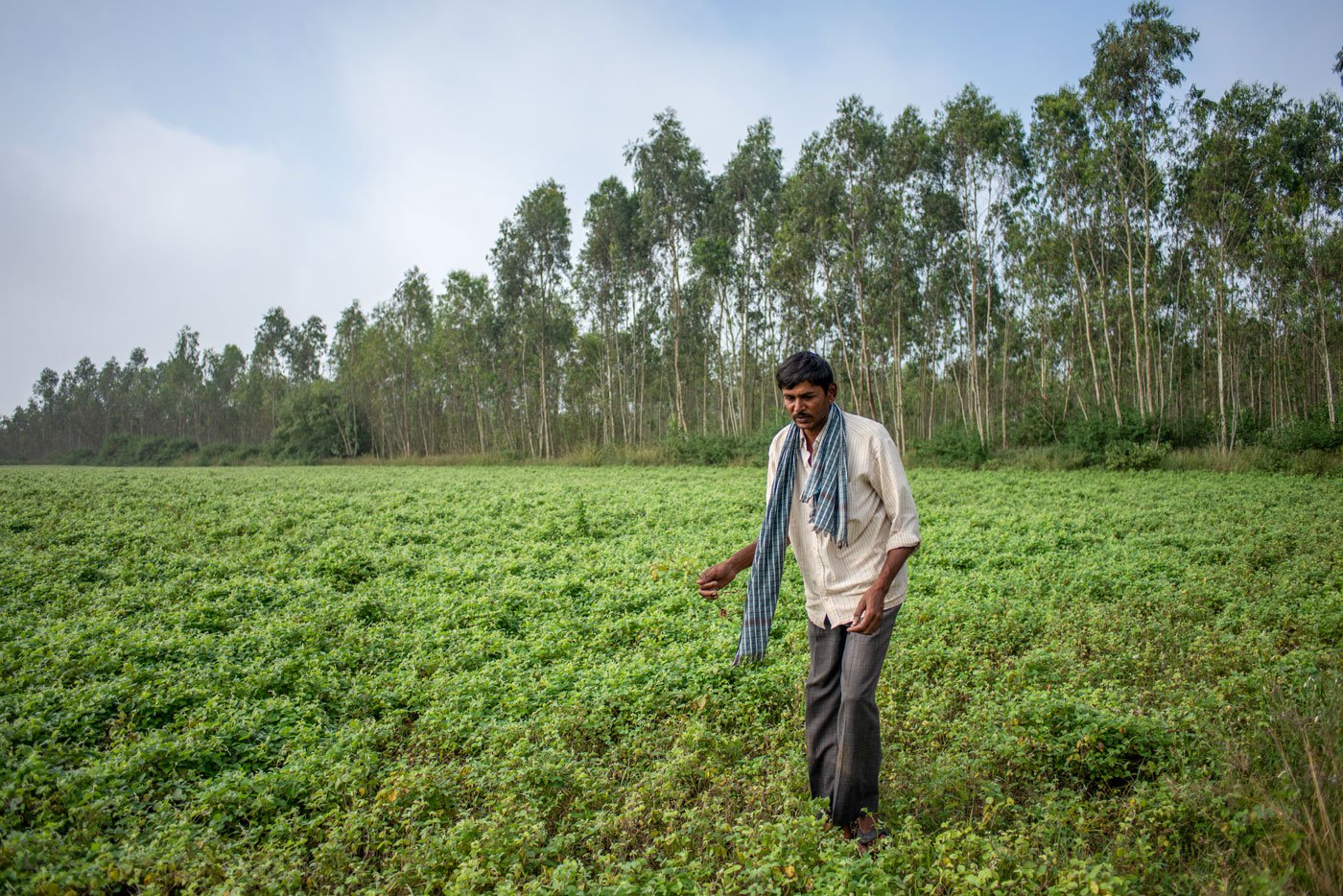
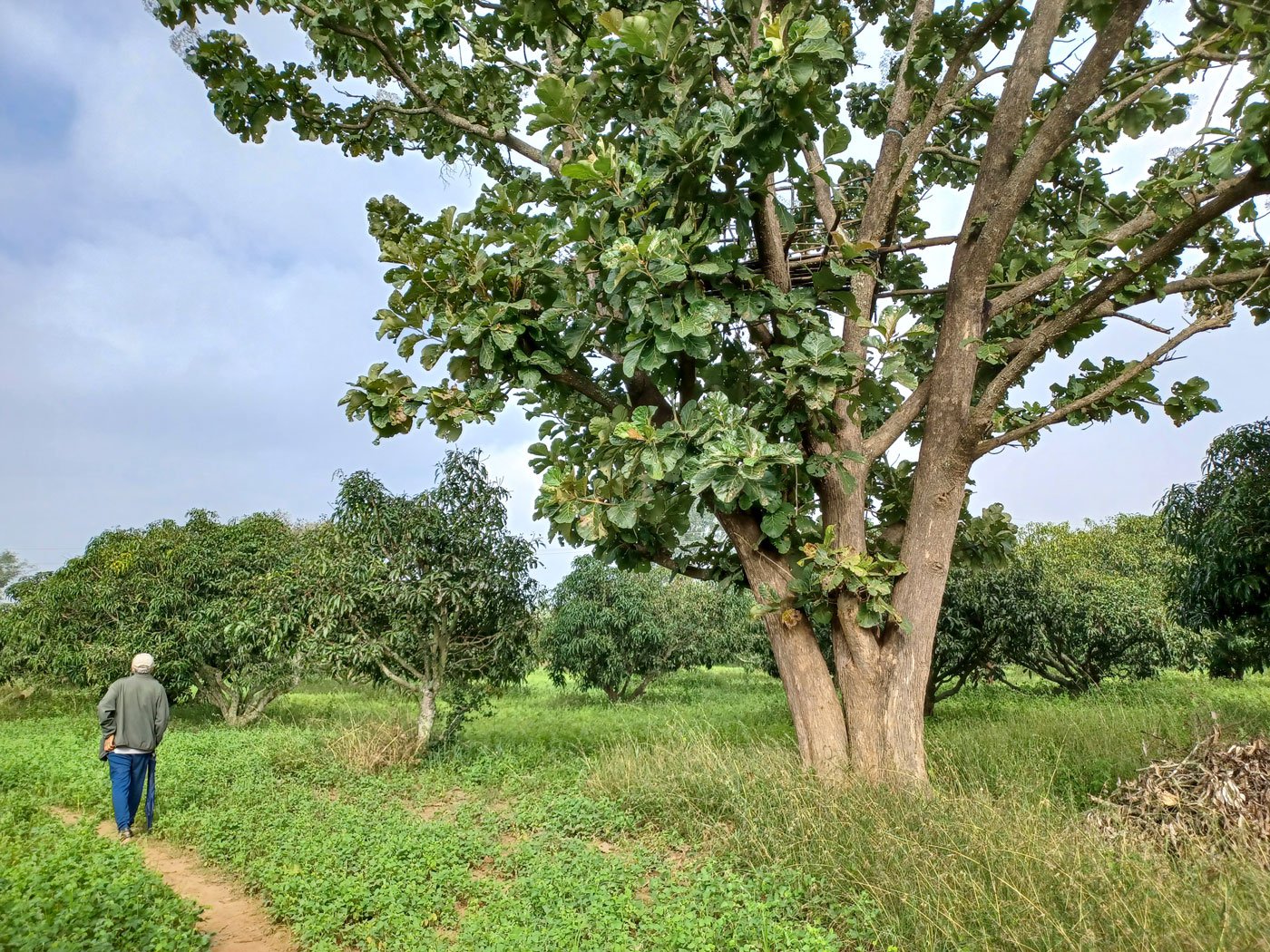
Left: Ananda inspecting the horse gram crop on his land. Right: The machan in a tree in Naganna’s farm, for spotting elephants in the
ragi
season
He shows us the rain damage – it is everywhere. “I have never seen such rain in my 86 years,” says an anguished Naganna. According to him – and his trusted Panchangam, the astrological calendar – this year’s rain is ‘Vishaka’, each type named after the stars. “ Oru maasam, mazhai, mazhai, mazhai .” A whole month, just rain, rain, rain. “Only today there is some sun.” Newspaper reports bear out his statement. They declare that Tamil Nadu received 57 per cent excess rainfall in 2021.
Walking back to Gopa’s farm, we meet two old farmers, sporting shawls, caps, and umbrellas. In chaste Kannada, they explain how much ragi cultivation has come down. Gopa translates for me.
K. Ram Reddy, 74, assures me that ragi is farmed in only “half the fields” today, compared to a few decades ago. “Two acres per family. That’s all we grow now.” The rest are filled with tomato and beans. And even the ragi that’s grown now is only “hybrid, hybrid, hybrid”, Krishna Reddy, 63, tells me, repeating the word for emphasis.
“ Naatu ragi shakti jaasthi [Native ragi is stronger],” Ram Reddy says, flexing his biceps to show off his strength. He puts his good health down to the native ragi he ate as a young man.
But he’s unhappy with this year’s rain. “It is terrible,” Ram mutters.
He’s not sure of getting any compensation. “Whatever the reason for the loss, we don’t get anything without a bribe. Plus, the patta [title deed] should be in our name.” That rules out tenant farmers getting any compensation.
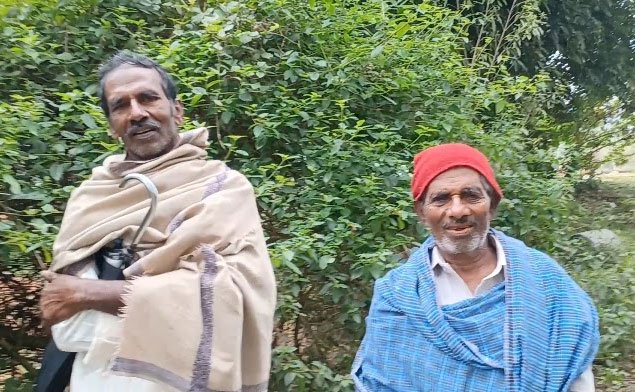
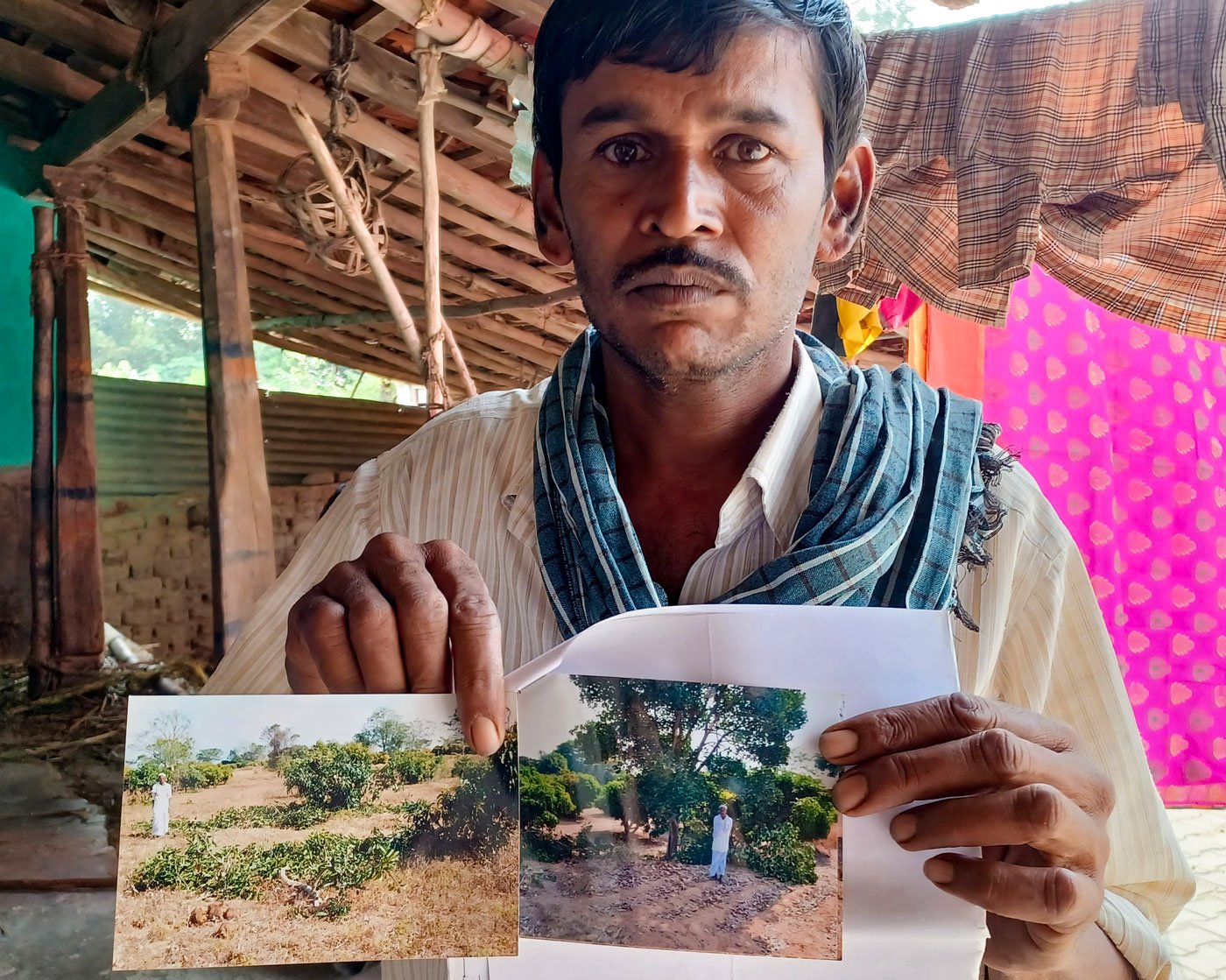
Left: Farmers Krishna Reddy and Ram Reddy (in the red cap) in Gollapalli. Right: Ananda with photographs of crops damaged by elephants
And that’s not always easy, Ananda explains sadly. His father was cheated by his uncle. And Ananda demonstrates the betrayal with a little skit. He takes four steps in this direction and four in the other. “That’s how he gave us land, by saying so many feet are yours and mine. My father is not educated, he simply agreed. We have registration papers for just four acres.” In reality, they are cultivating more, but cannot file for compensation for any damage other than what occurs on the four acres they officially own.
Back in his verandah, he shows us photos and documents. An elephant raid here, a pig raid there. A fallen tree. Trampled crops. His father, tall and forlorn, standing in front of a toppled jackfruit tree.
“How can you make money in agriculture? Can you buy a nice vehicle? Fine clothes? The income is so poor, and this I say as someone with land,” argues Naganna. He has changed into formal clothes: a white shirt, new dhoti, cap, mask and kerchief. “Come with me to the temple,” he tells us. And we are happy to oblige. The festival he was going to was also in Denkanikottai taluk , half an hour away on a ‘star’ (superior quality) road.
Naganna gives us crisp directions. He gives us a commentary on how much the area is changing. The rose farmers have taken out big loans, he says. They fetch between 50 and 150 rupees a kilo, going up during the festive season. The most attractive feature of the rose, from what I hear, is not the colour or fragrance – but the fact that elephants don’t like to eat them.
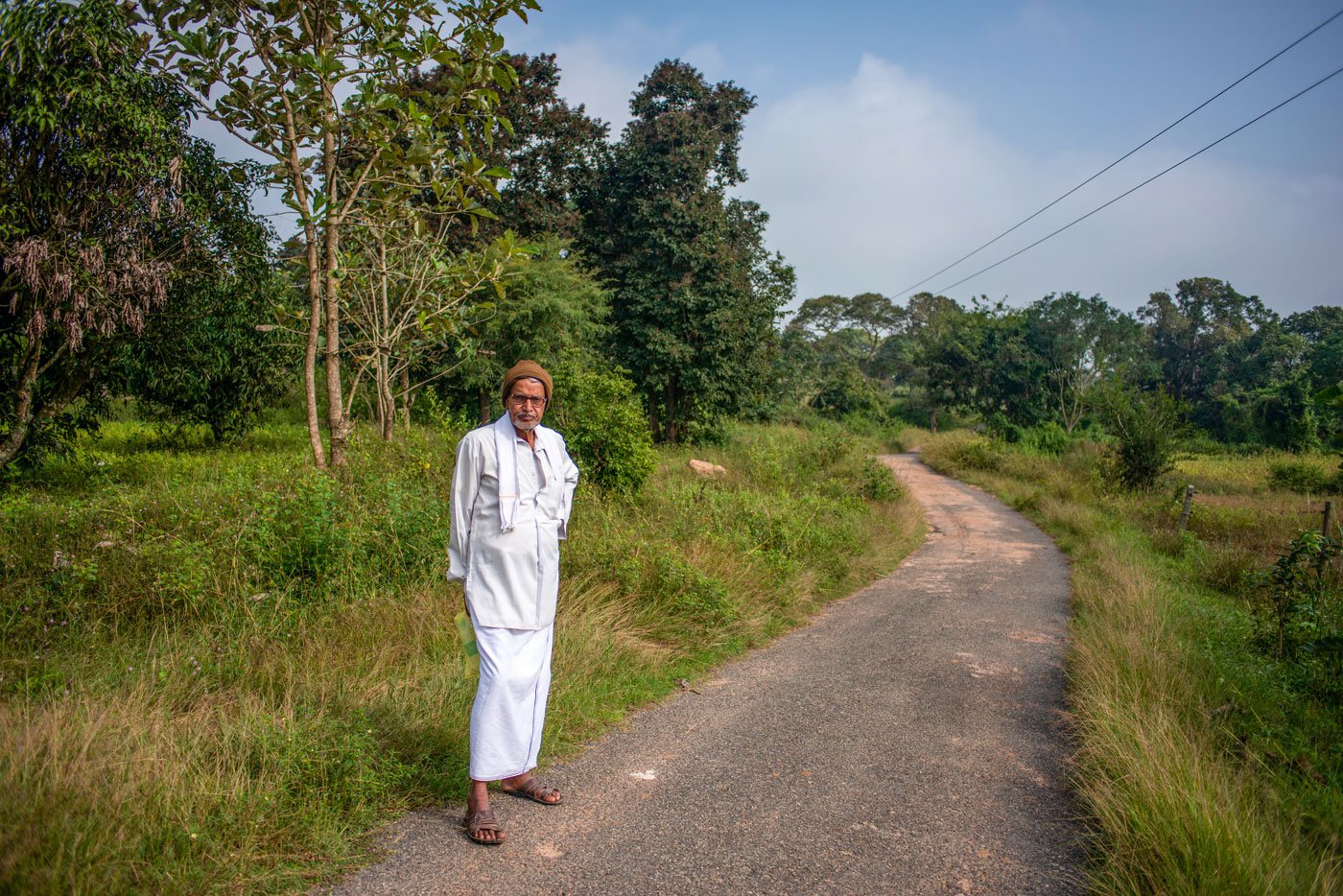
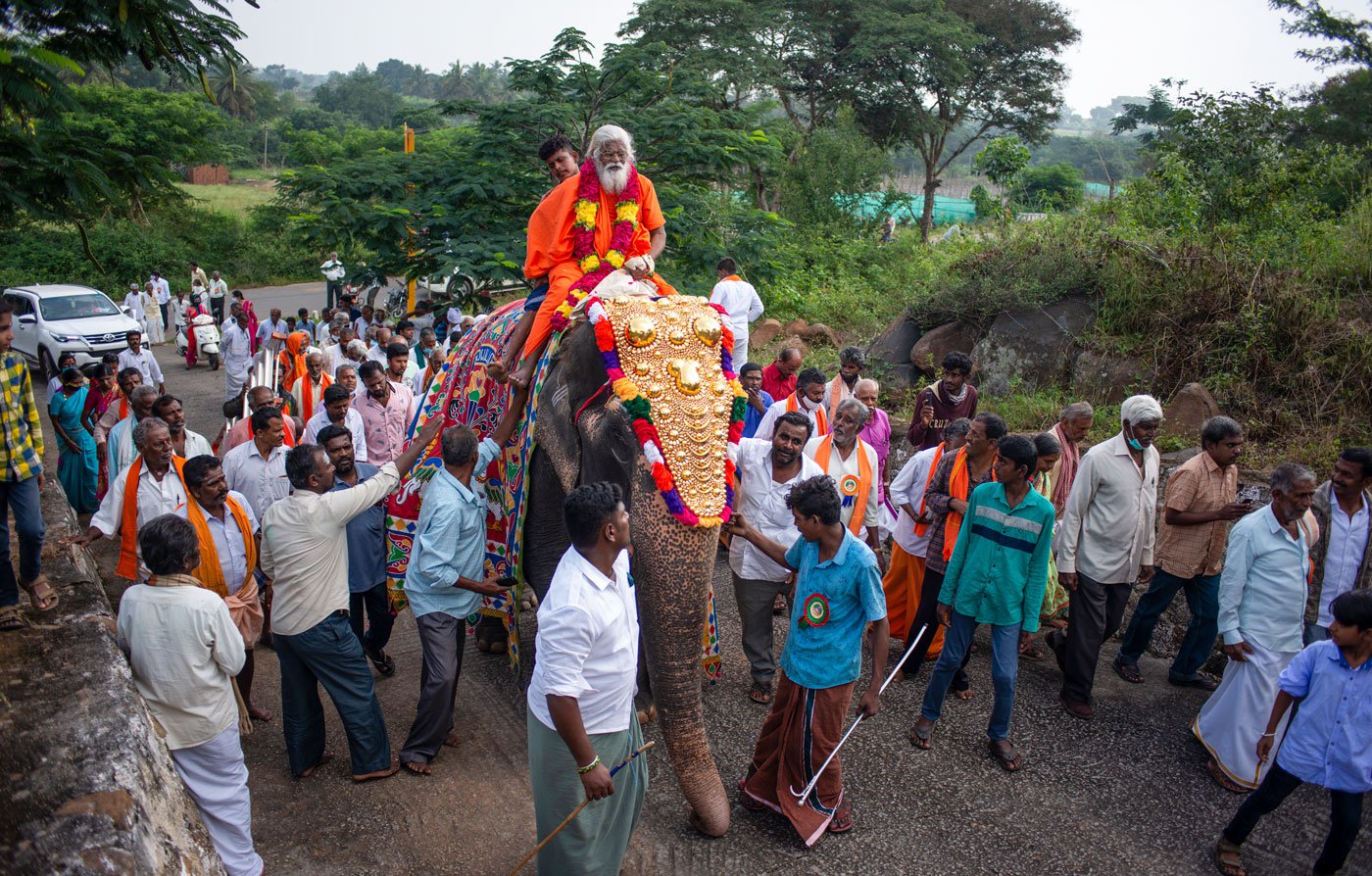
Left: Naganna setting out for the temple festival in Denkanikottai. Right: The elephant leading the festival procession was brought from another temple
The closer we get to the temple, the more the roads are crowded. There is a long procession and – surprisingly – an elephant. “We’ll meet the aanai ,” Naganna predicts. He invites us to have breakfast in the temple’s kitchen. The kitchidi and bajji is heavenly. Soon, the elephant – from a temple in another part of Tamil Nadu – arrives with a mahout and a priest. “ Pazhutha aanai ,” Naganna says. Old elephant. She moves slowly, gently. With their mobile phones raised, people take hundreds of photos. Just 30 minutes from the forest, it’s a very different elephant story.
And I recall what Ananda had said, sitting on his haunches in his verandah, a towel draped around his neck. “If one or two elephants come, we don't mind. For the young male elephants, nothing is a deterrent. They do a rowdy jump over any fence and eat.”
Ananda understands their hunger. “For half a kilo of food, we struggle so much. What will the elephants do? They need 250 kilos each day! We can earn 3,000 rupees from a jackfruit tree. The year the elephant eats everything, we just think God has visited us,” he smiles.
Yet, he nurses one wish: to someday raise 30 or 40 sacks of ragi . “ Seiyanam , madam.” I must do it.”
Mottai Vaal willing…
This research study is funded by Azim Premji University as part of its Research Funding Programme 2020.
Cover photo: M. Palani Kumar
